I was cleaning up computer files last night and found this photo. Thom took it in March 2010.

I was cleaning up computer files last night and found this photo. Thom took it in March 2010.

Yes, tonight’s concert was a blast from the past. Frankie Valli and the Four Seasons played at the Family Arena in St. Charles. Ted and I didn’t know if Frankie had a decent voice left, but even though he’s 83, he still sings pretty well–just in a slightly lower key. The crowd cheered when he did his famous falsetto notes! (Maybe because we love them; maybe because we were surprised he still has that much voice range. Who cares?–He did it!) The Four Seasons are apparently interchangeable over time and were much younger (40s?).
The show was scheduled for 8:00 pm, but didn’t start until 8:15. I heard the man behind me tell his wife that they were probably giving Frankie oxygen to get him ready to perform. (Yes, we old folks have a sense of humor about age.) The average age of the audience was probably 65-70. The sign at the concession stand said “We ID everyone.” Ted and I wondered if there was any point in that, given the audience’s age, but then we saw about a half dozen kids whose parents (or grandparents) probably dragged them to the concert. They brought the average age down a few minutes.
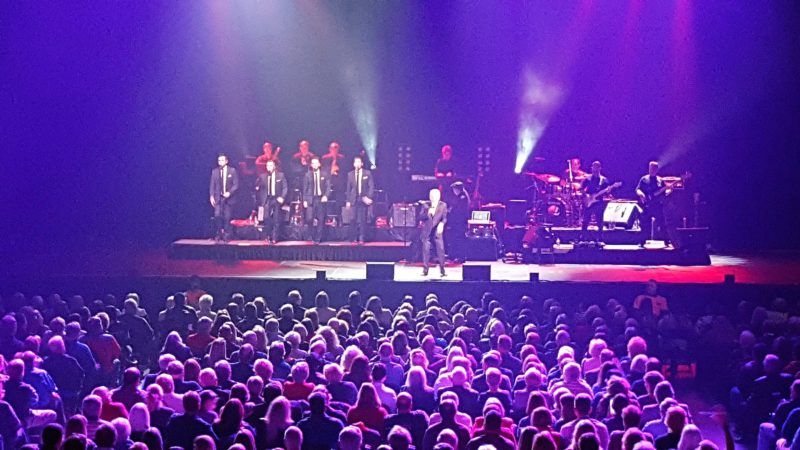
Frankie might be old, but he didn’t get fat. He has a good band too. Tonight, it included two local musicians on the trombone and the trumpet (the two on the left in the back). The four guys in suits on the left are the Four Seasons. (Duh!)
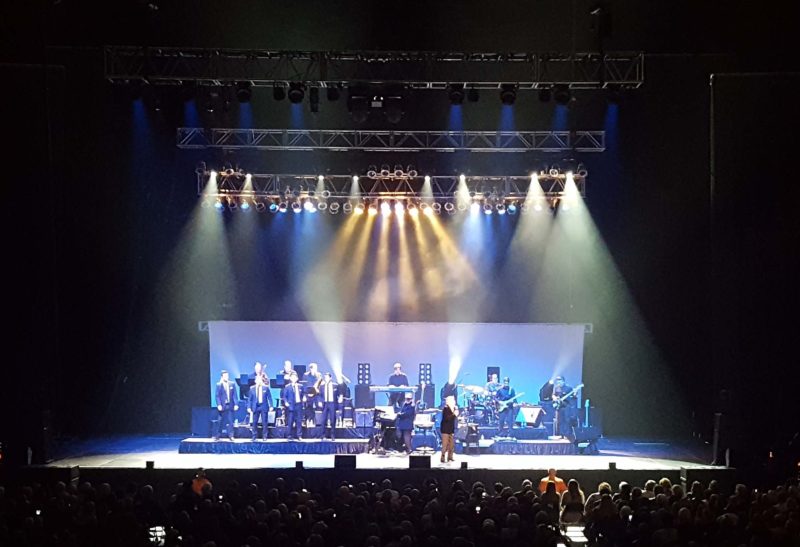
Frankie still sings well enough to do solos. In fact, he and the Four Seasons just released a new album–“Romancing the 60s.”
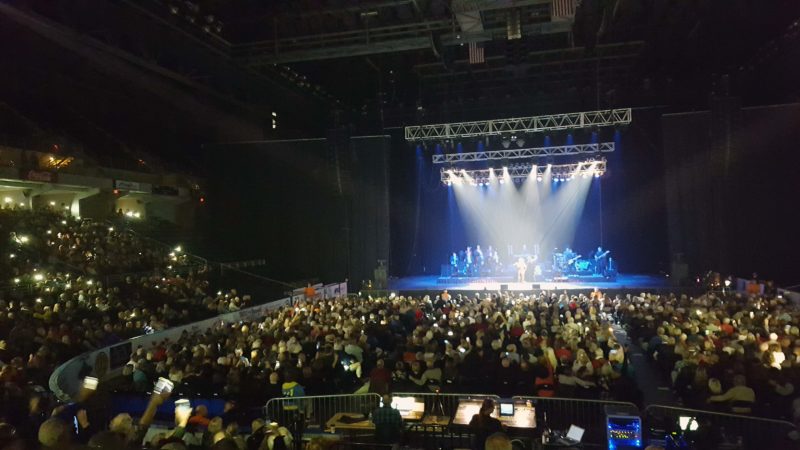
When Frankie sang “Can’t Take My Eyes off of You,” the crowd broke out the cell phones and the flashlight app to do the arm wave thing. We’re baby boomers: we’re aging, but we’ll always be cool.
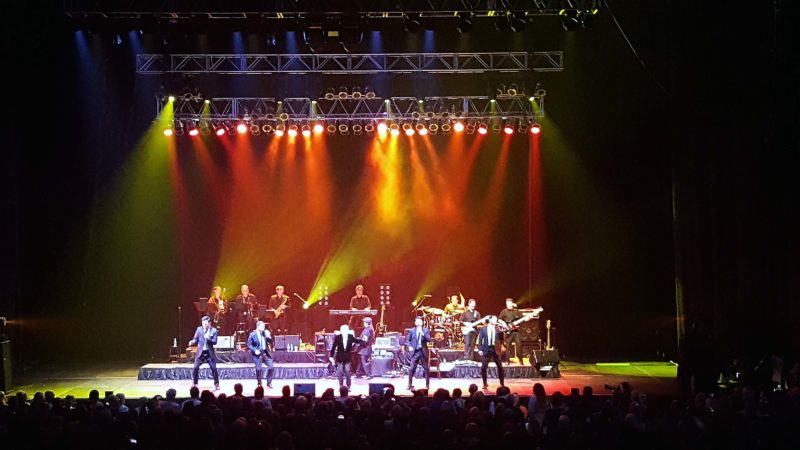
Frankie sang all his big hits and the crowd loved it. The Four Seasons’ moves were all choreographed–just like in the 60s. In this picture, they’re singing “Oh, What a Night.”
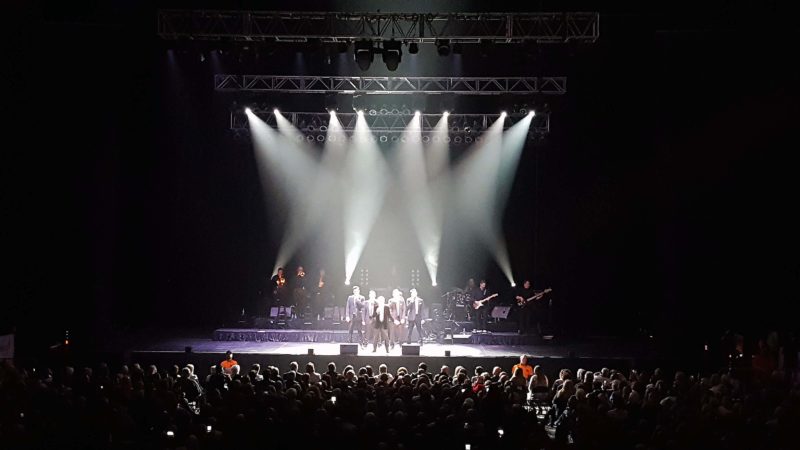
The finale. All good things end.
The concert was very good. Ted and I agreed the tickets were worth it, and I heard a lot of other people complimenting the performance as well. As I was looking over the crowd before the show began, it made me think of the PBS pledge week doo wop specials, but after the lights went down and you couldn’t see all the gray hair (mostly on the men, of course), you wouldn’t have guessed it was an old crowd. Party on, Baby Boomers!
Ted and I kicked off the concert season at the Hardin Middle School orchestra’s winter concert. Sky and Dylan are cellists in the orchestra.
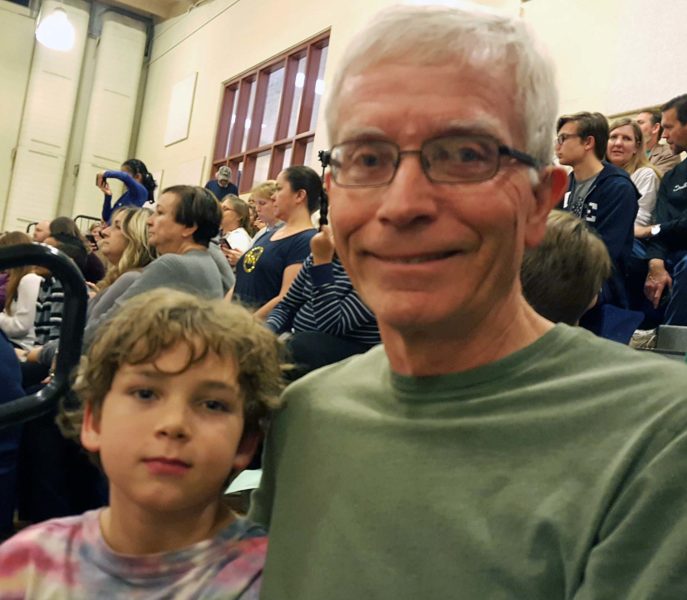
It’s Big Teddy and Little Teddy, ready to hear some music.
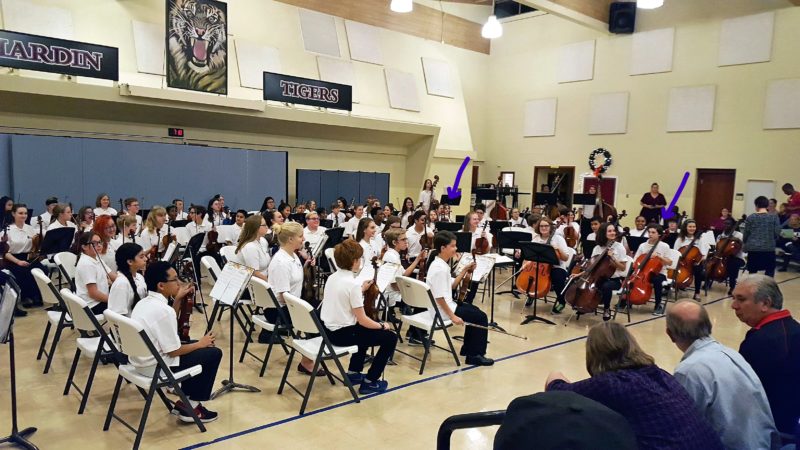
The orchestra is warmed up and ready to play. Arrows point to the people we are most interested in–Dylan in the center ahead of the bass, and Sky on the right in the front chair.
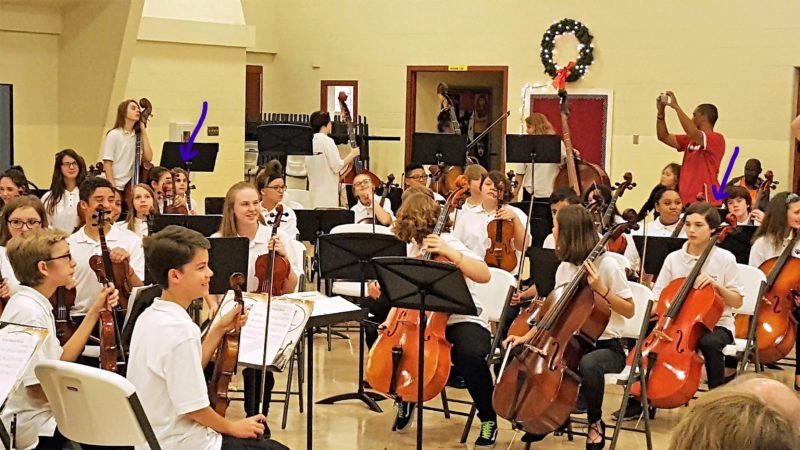
Here’s a closer view of our boys.
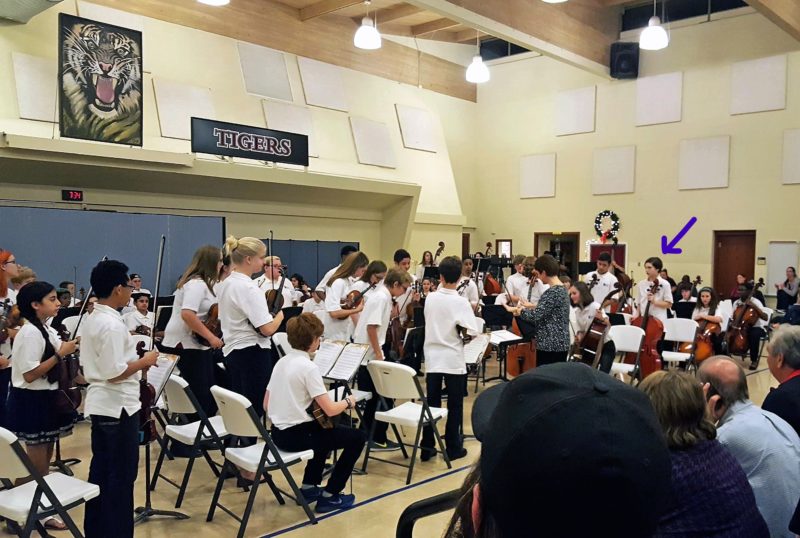
Only the eighth graders played the most difficult piece. Afterward, they stood to take a bow. Sky is already in eighth grade!
Ted and I always look forward to these concerts, and we enjoy them. The holiday music season has officially begun for us!
Ted and I were going through our pictures from our Southwest trip and I found one I meant to blog. It’s a picture of an awesome chocolate fountain at a candy shop in the Bellagio Hotel in Las Vegas. Go ahead–salivate!

Tonight, Ted and I decided it would be fun to watch National Lampoon’s Christmas Vacation. There are a lot of laughs in the movie, but our favorite moment is always the one when Clark turns on the outdoor lights and Chicago dims.
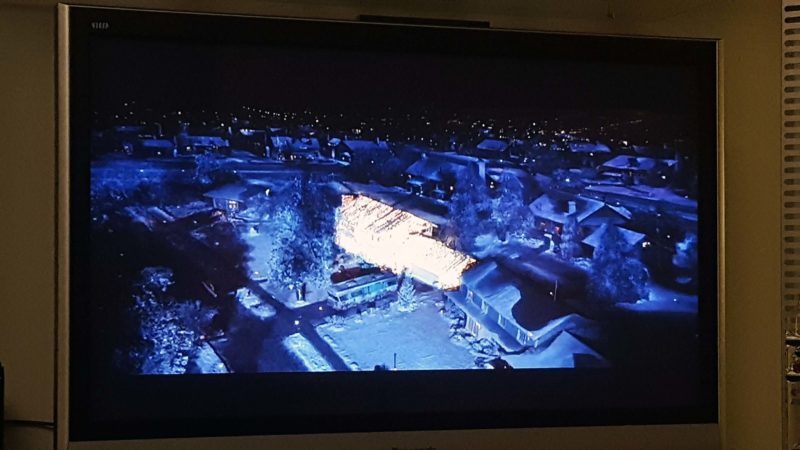
This was a St. Louis headline today. The high-end Parkway School District in western St. Louis County has a very ethnically diverse student body. An African-American Parkway Central girl was interviewed about this incident for a TV newscast. She said nothing like this has ever happened to her before. My first thought upon hearing her statement was that our President and others in high positions have made it acceptable to speak in derogatory and divisive terms of people who disagree with them, and/or of people who are not like themselves. As a result, incidents like this seem to be increasing in number.
In my opinion, the recent well-publicized tweet exchange between Chairman Kim of North Korea and President Trump approaches cyber bullying–a crime in most states–and definitely falls into the category of body-shaming. That two world leaders would address each other in such a disrespectful (and public!) manner is shocking to me.
Regardless of one’s opinion of these two world leaders, they (and far too many other influential people) are speaking and acting in ways that no mother I’ve ever known would allow. In addition to the hate speech that is becoming daily news, it’s getting hard to keep track of the number of well-known and highly-positioned men currently accused of improper sexual conduct with children and women. When will this divisive and disrespectful behavior stop? My mother taught me that I didn’t have to like everyone I met, and that I didn’t have to make them my best friends, but I was never to treat others without the respect due to them as human beings. I thought that’s what all mothers taught their children. Apparently, this is not true.
I try to avoid becoming political in this blog, but I’m tired of sitting quietly by while hate and divisiveness are chipping away at our valuable American melting pot. Just as many state and local governments are trying to do the right thing in the absence of federal leadership and support (raising minimum wages, funding infrastructure projects, fulfilling the Paris Accord commitments, etc.), we–the people–are going to have to be the ones to say “this is wrong” and to demonstrate respect, tolerance, and inclusiveness to other individuals, regardless of race, creed, color, or gender.
Since Ted and I came home two days early from our Southwest trip, we got an early start on some jobs we had to do. Number one: Ted gave the car a good, hard scrubbing and took off the grit that car washes don’t. He vacuumed, dusted, and detailed everything, including putting on a coat of wax. Meanwhile, I unpacked a month’s worth of stuff and put it away.
Things looked a little different than when we left home in early October.
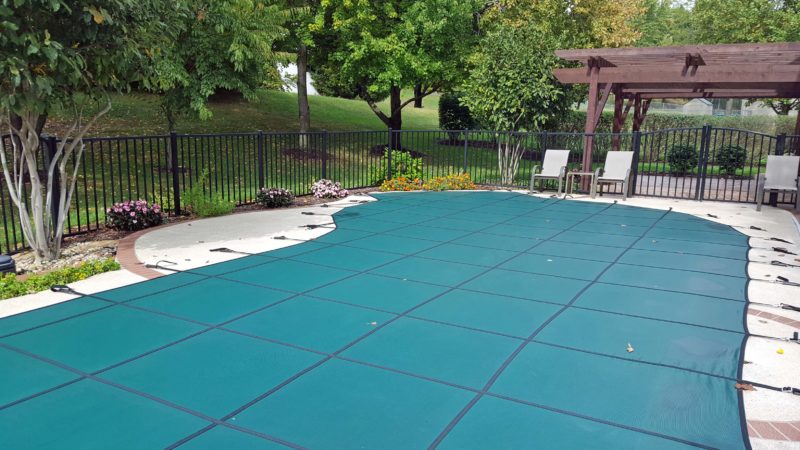
When we left, the trees were still green and flowers were still blooming. Temperatures were in the middle 80s.

When we came home, the peak of fall color was already a thing of the past. Temperatures are in the middle 40s.
I went out to lunch with friends today (a lunch I thought I’d miss because we’d still be in Kansas), and Ted spent that time raking leaves. When I got home from my lunch date, I finished blowing the leaves in the back yard so Ted could go to buy gas for the chipper.
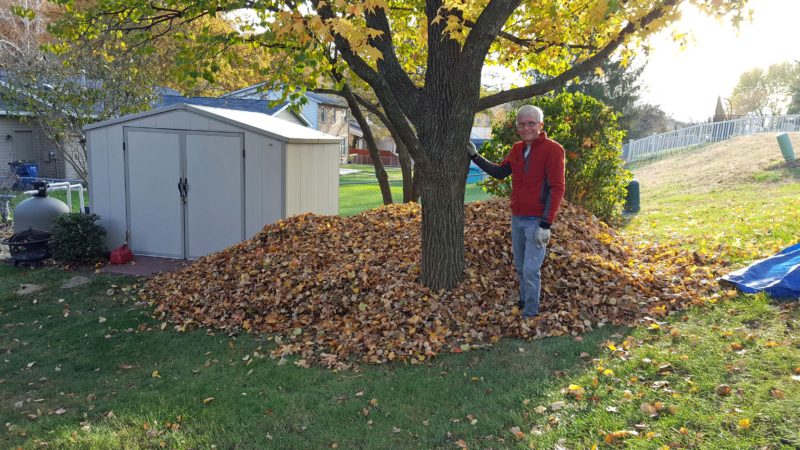
A lot of leaves had fallen in the yard!
Every year, when we rake up a big pile of leaves, Ted and I say we should jump in the pile, but we never do. This year, we did it. We stood on the edge of the pile and just fell over backward. The pile was soft and we fell deeper than we’d expected. We were completely buried and had to dig our faces out.
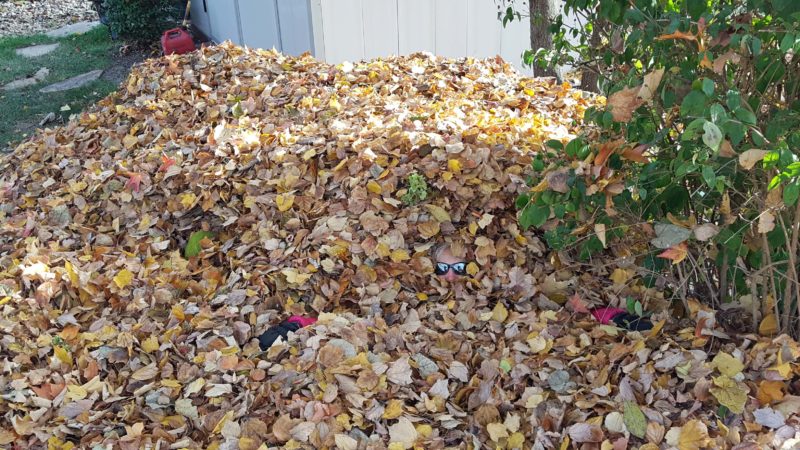
You can see a little bit of the pink sleeves on my jacket. Look between them to find my sunglasses. My legs are buried in the foreground. The dent on the left is where Ted jumped in and climbed out.
That was fun! We’ll have to do it again next year. Are we getting older, or reverting to our childhoods? First, sand sledding and now jumping in a leaf pile. After the fun, Ted started up the chipper to get rid of the leaf pile and I started dinner–a real, home-cooked meal. No hunting for a restaurant tonight.
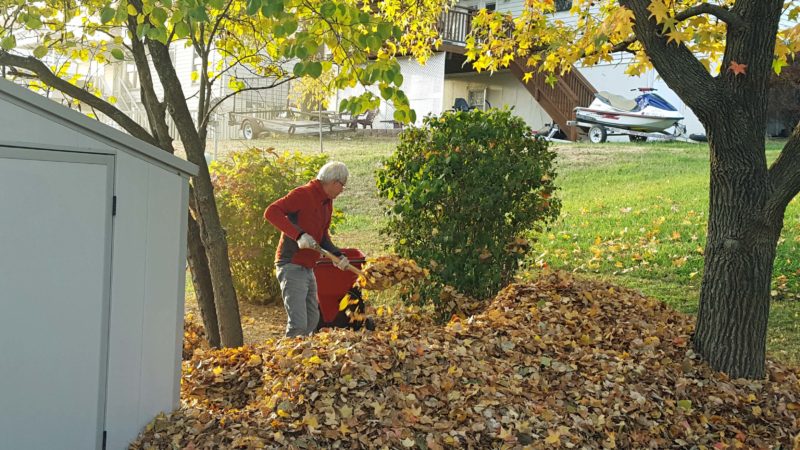
It took about an hour to make the leaf pile disappear through the chipper.
The trip was fun, but it’s always good to come home.
We left Jeff’s house this morning and headed for the Monument Rocks (chalk cliffs) near Oakley, KS. Last night, we set our alarm an hour early to compensate for the change to CST and to allow daylight time for viewing the Monument Rocks. Jeff and La asked when we’d be getting home, and we told them we were planning to spend today and two more days in Kansas, arriving home Friday night (this is Wednesday).
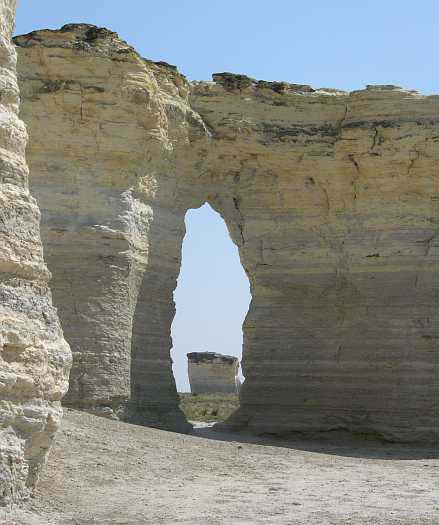
Some of the chalk cliff formations. (Thank you, Google.)
We stopped in Colby for lunch, at the turn-off to Oakley . . . Maybe it was because the weather was cold . . . Maybe we’ve been traveling too long . . . Maybe we’ve spent too many years driving directly east and west on I-70 when we visit Jeff’s family . . . Whatever it might have been, Ted and I suggested to each other that maybe we should just go home. We calculated what time we’d get home (around midnight because we hadn’t left Jeff’s house as early as usual), decided we could live with it, and hit the road.
We had a wonderful trip around the Southwest.
…States visited: 9 (Missouri, Oklahoma, Texas, New Mexico, Arizona, Nevada, Utah, Colorado, Kansas)
…Miles driven: 6,070
…Days away from home: 31
…Time zone changes: 6 (CDT to MDT in New Mexico; MDT to MST in Arizona–they don’t do daylight time; MST to PDT in Las Vegas–a 2-hour time difference; PDT to MDT in Utah; MDT to MST in Colorado–daylight savings time ended; and MST to CST in Kansas.) At one point, we were so unsure of what time it was and which devices were showing the correct time, that I actually called the hotel desk to ask what time it was so we could set our alarm for the correct time!
…Significant sites visited: 10 national parks; 5 national monuments; 3 national sites (VLA, Hoover Dam, Kitt Peak Observatory); 2 state parks; and 1 UNESCO World Heritage Site.
…Highlight of the trip (if we have to choose only one): the mass ascension of 550 balloons at the Albuquerque Balloon Fiesta.
…Fun we had: infinite.
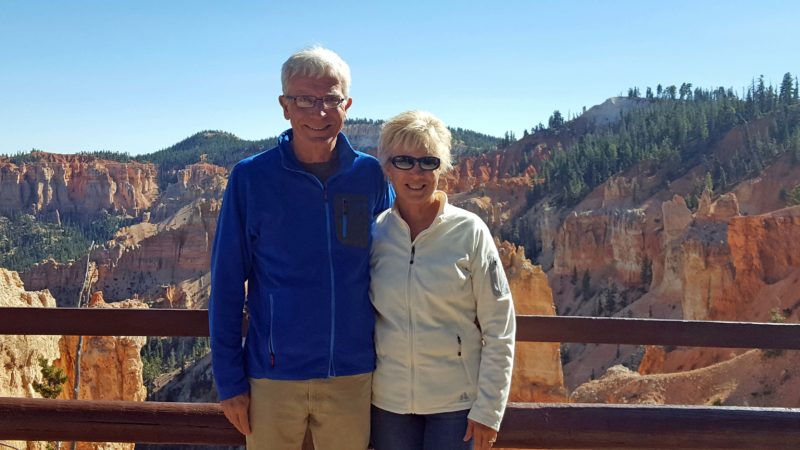
Ted and I have been looking forward to our stop in Longmont, CO to see Alex for the first time in 25 months. He just returned from his mission in Peru on November 5, and we arrived at the house on the 6th, so we didn’t give him much time to recover from the international travel or to re-acclimate himself to the U.S. After two years, it’s obvious he is a mature young man who’s had a very enriching experience. We’re so proud of him! We had a good time with the family and, as always, were sorry to have to leave and be on our way.
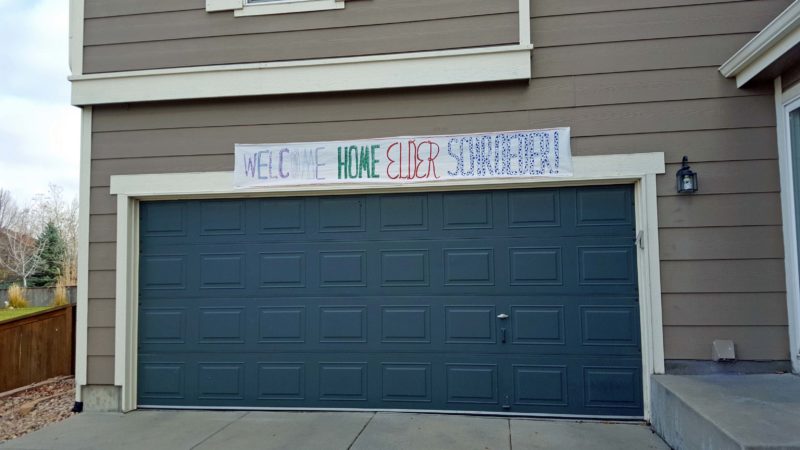
It looks like Jeff, La, and Zaque were excited about Alex’s homecoming too.
Jeff’s first ultimate frisbee game of the winter season was scheduled during our visit, so we watched his team play two twenty-minute fast-paced indoor games.
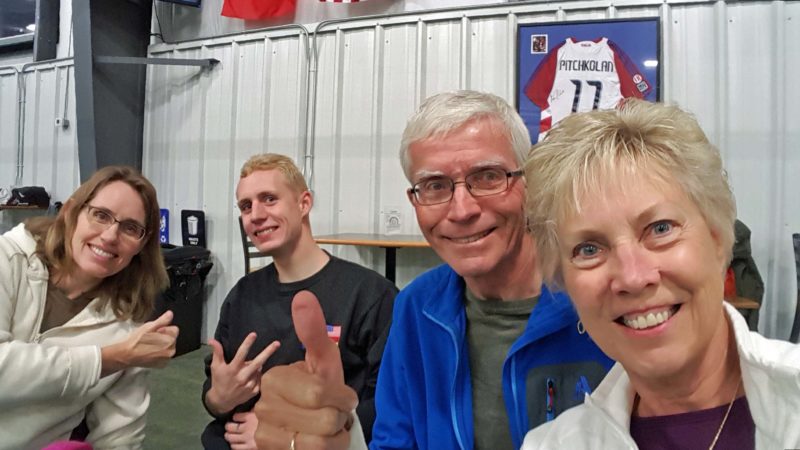
Here’s Jeff’s cheering section.
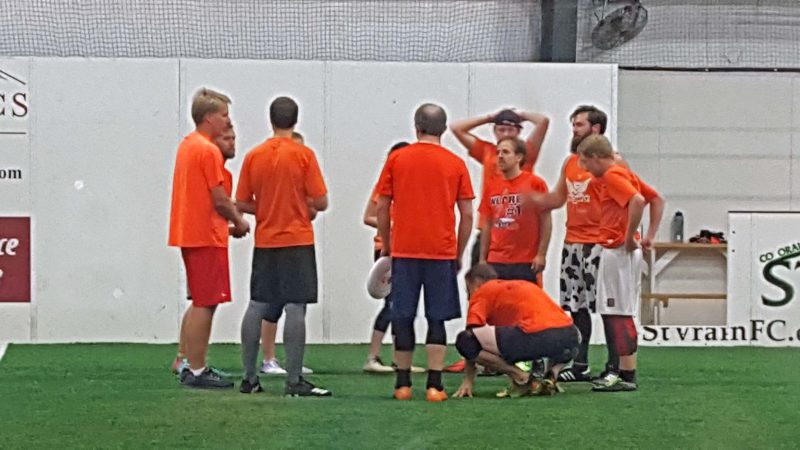
Jeff is a team captain, so I assume he’s giving the team a pre-game pep talk here, even though the team looks pretty relaxed at the moment.
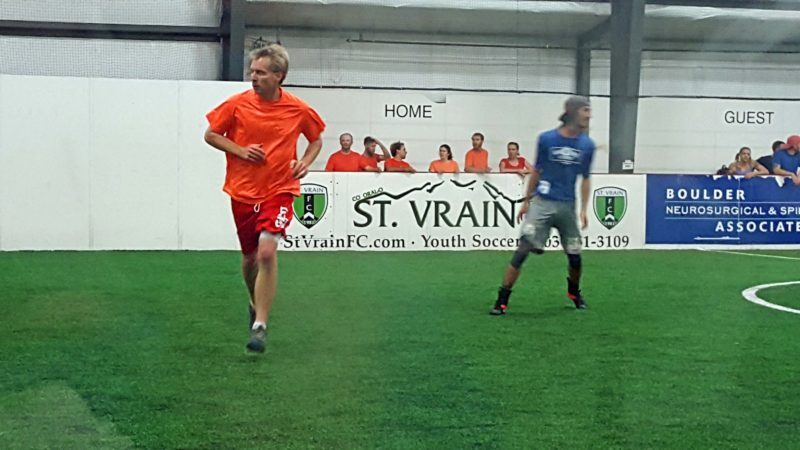
Jeff in action.
Since Alex has been gone for two years, we needed to take some family pictures.

Here we are, looking at some of the pictures Alex took while he was in Peru. Zaque had already gone to bed.
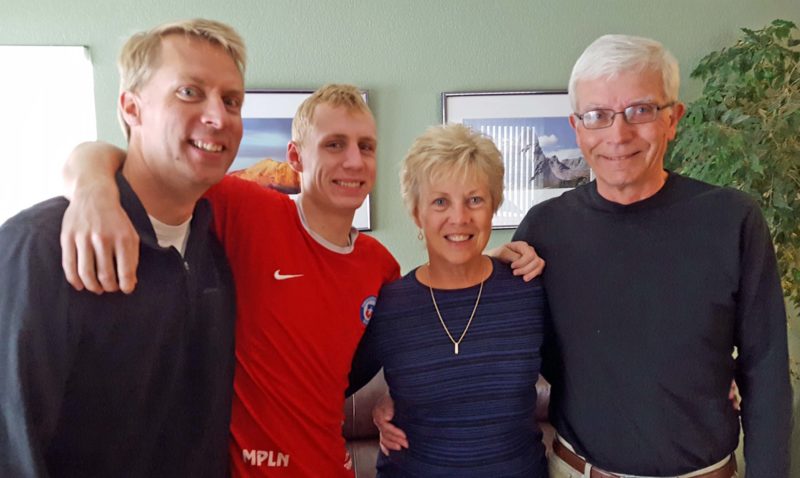
And here we are the next morning. Zaque was in school.

Yet another grouping–Ted and me with our elder son.
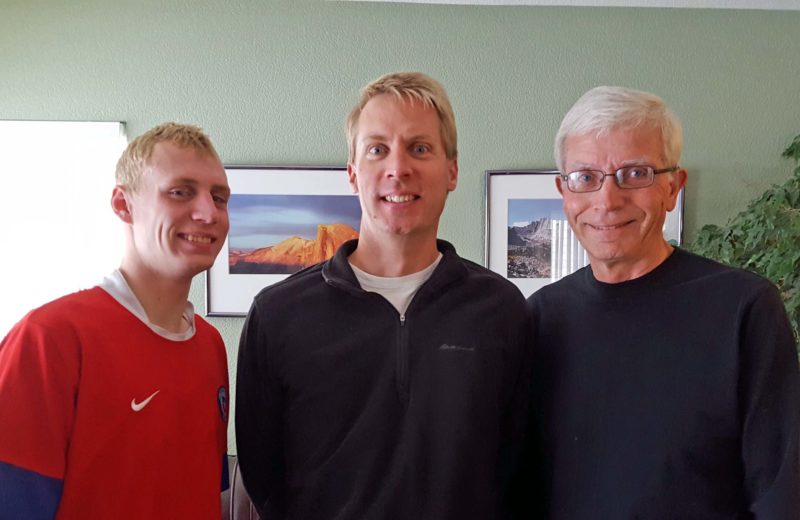
Our final shot: three generations of Schroeder men–Ted, his elder son, and Jeff’s elder son, our eldest grandson.
I think we need to do a better job of scheduling our trips. At the start of our Spring Break Road Trip, we had three inches of snow in Nashville, TN and three more in Asheville, NC. At the end of this trip, we had three inches of snow in Longmont, CO.

It must be time to get home and put the flannel sheets on the bed!
Following our Royal Gorge Route train ride, Ted and I returned to Pueblo, where we are spending the night. Pueblo’s Riverwalk and Historic District were a 5-10 minute walk from our hotel, and we had plenty of time to explore them–a little. It was Sunday afternoon, and not much was open, but it was good to be outside and getting some exercise, even though it was only 42 degrees.

Pueblo’s Riverwalk is not in the San Antonio Riverwalk class, but it was pretty. It looks like it might be a new development, so maybe it needs some time to attract more businesses along the Arkansas river.
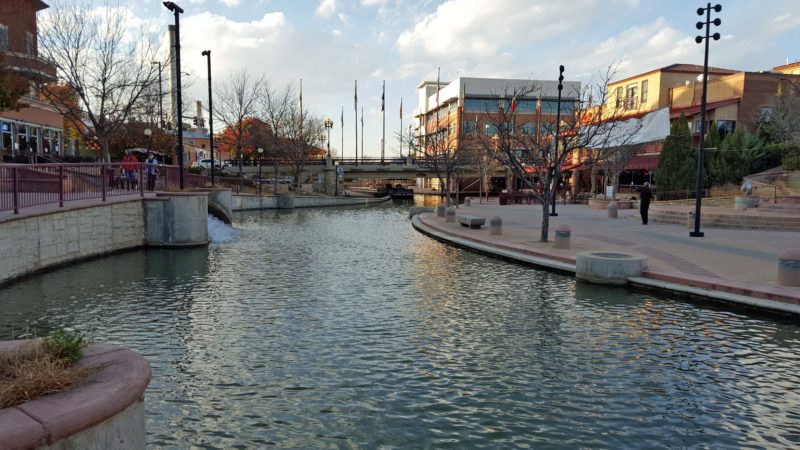
Here’s another view of the Riverwalk. They’re hard to see in the shadows, but on the left walkway, there’s a couple walking. The lady is wearing a red jacket. Now look in the previous picture and find the lady in the red jacket. Same lady. That couple was walking in the opposite direction as we were, so we saw them coming and going both ways.
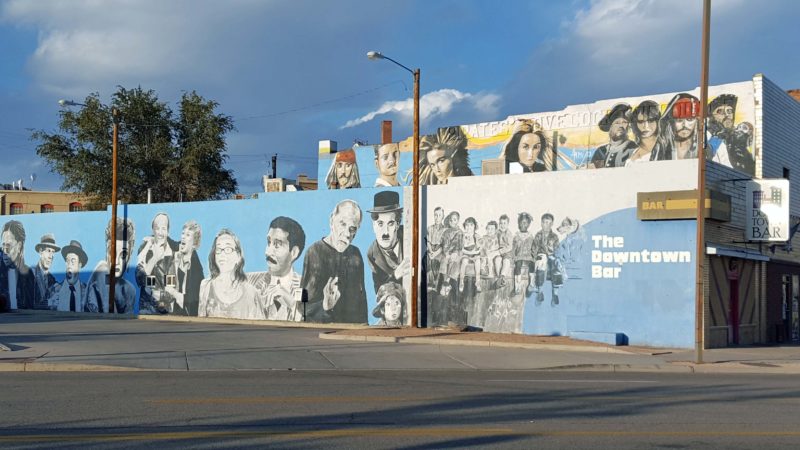
I’m not sure of the reason for this mural, but it was fun to identify the people depicted by the artist.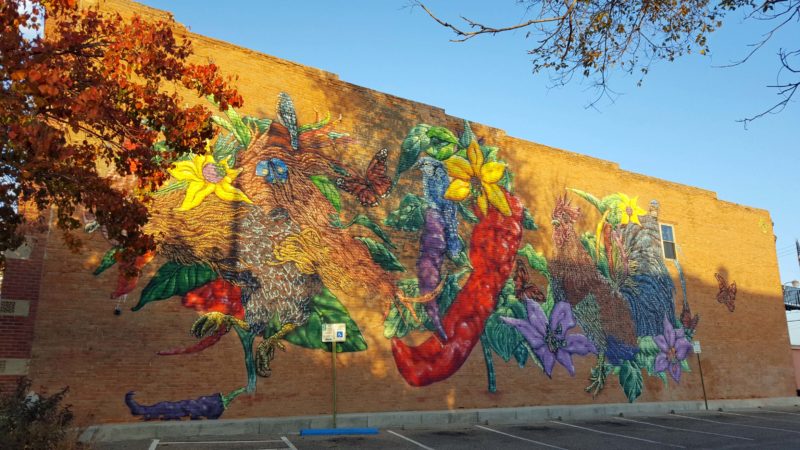
Nearby was another mural including the omnipresent Southwest chili pepper. We see them depicted everywhere, including on personalized license plates and in souvenir shops.
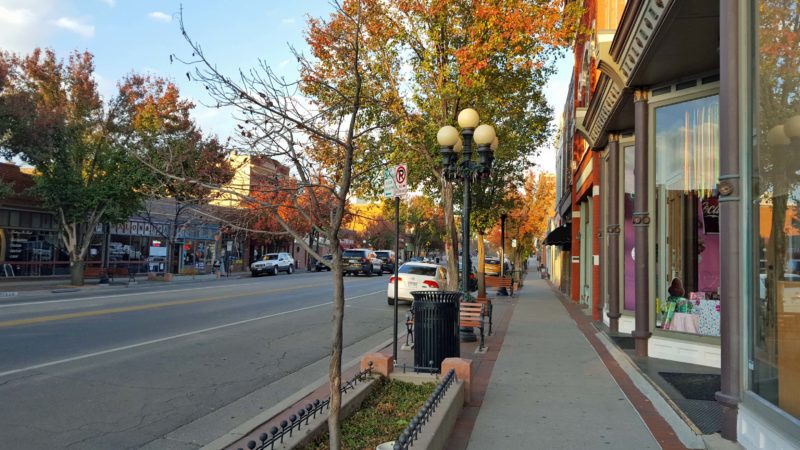
Here’s a view of the main street through the Historic District. There were some architecturally beautiful buildings in this area.
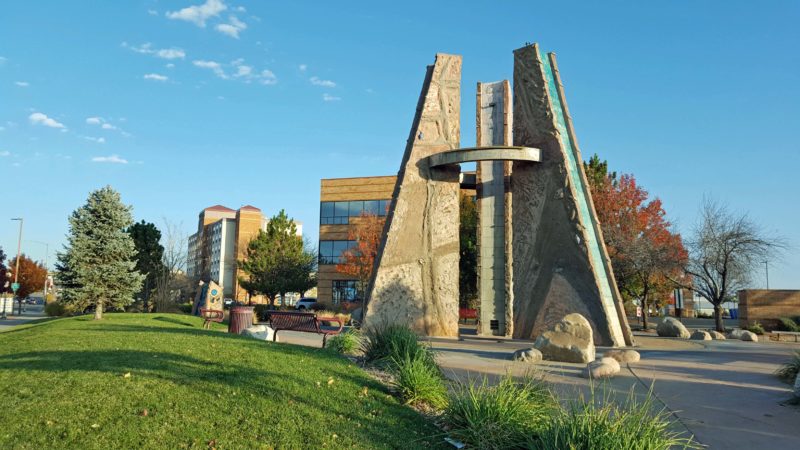
This sculpture was near our hotel (the building in the far left center of the photo).
We enjoyed Pueblo’s Riverwalk and Historic District, but were ready to come indoors to warm up after an hour in the 40-something temperature. We decided to relax in the hotel’s seating area with a cup of hot chocolate. These are the good times!
Today, Ted and I took a two-hour train ride through the Royal Gorge. Trains always run along the rivers in the bottoms of canyons, so I didn’t have to worry about heights. The Royal Gorge Route Railroad is a “heritage railway”–one that preserves railway scenes of the past. The route follows the Arkansas River between the 1,000-foot tall granite cliffs of Colorado’s grandest canyon, and is described as “America’s most spectacular rail journey.” When Teddy Roosevelt rode this route, he called it “the trip that bankrupts the English language.”
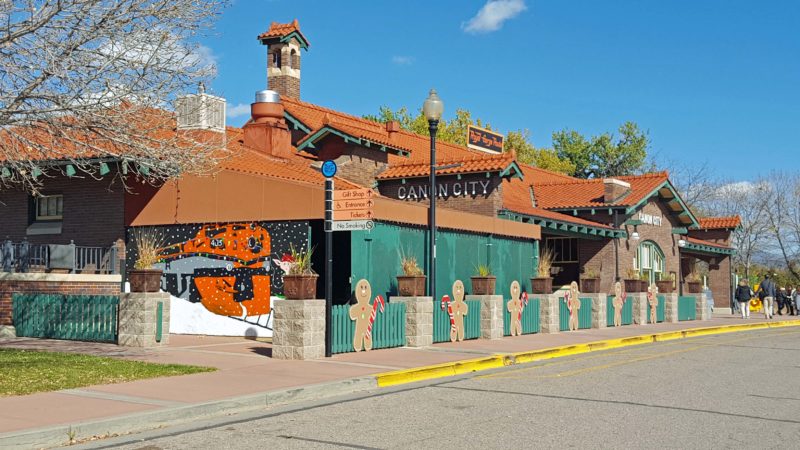
The Royal Gorge Route departs from the Santa Fe Depot in Canon City, CO.
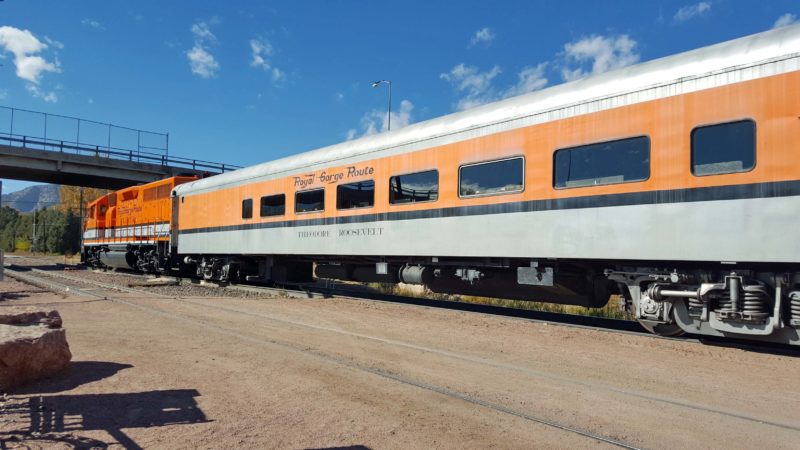
The first car of the train is named “Theodore Roosevelt.” Each of the 10-12 cars had a different name.
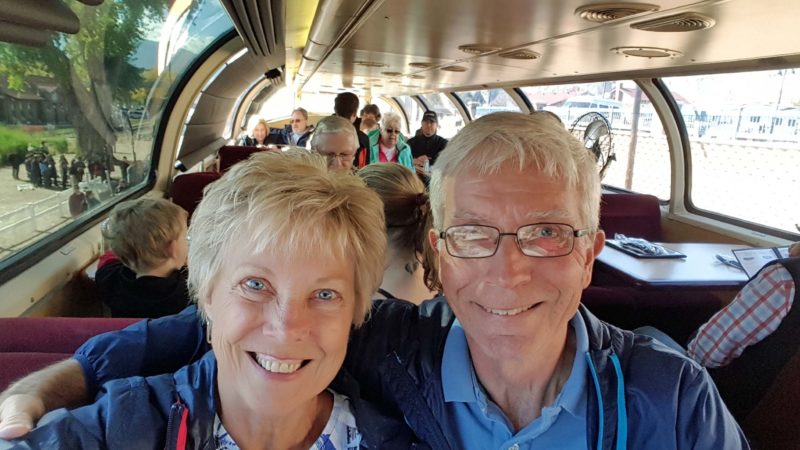
Here’s that good-looking couple again! We had tickets for a vista dome car, so our views were wonderful.
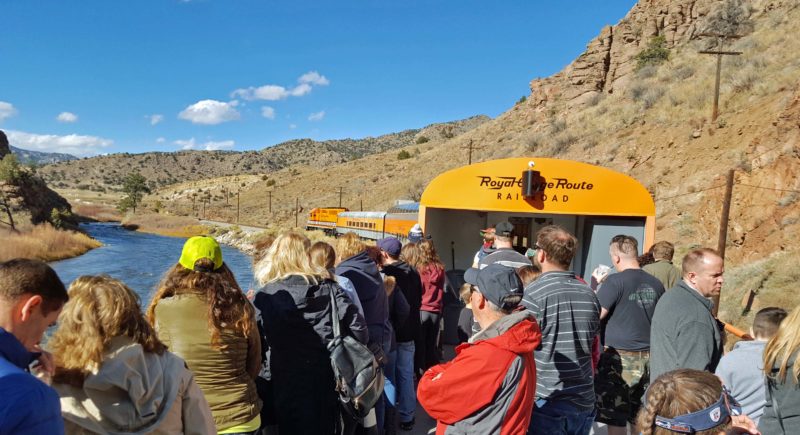
There was an open-air car for unobstructed viewing. The train moved slowly, so it was a safe ride, but it got cold in the shadows between the canyon walls.
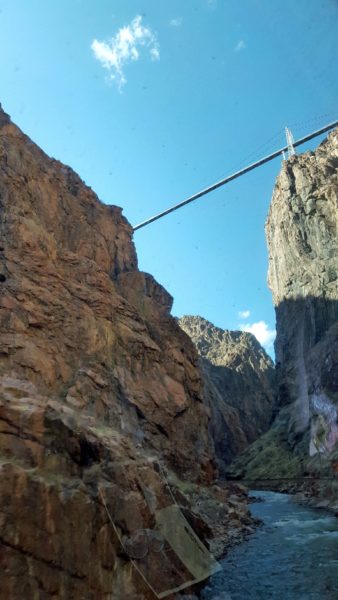
This is the Royal Gorge Bridge–955 feet above us. We could see people walking on it and looking over the sides.
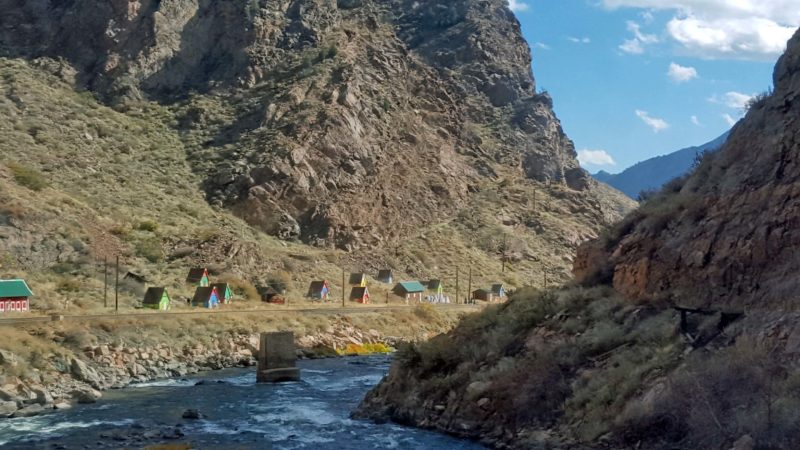
The holiday village is ready for the Santa Express in December.

Can you see the man’s face in the center near the top of the canyon wall? He is called “The Guardian of the Gorge,” and his name is Cliff Rock.
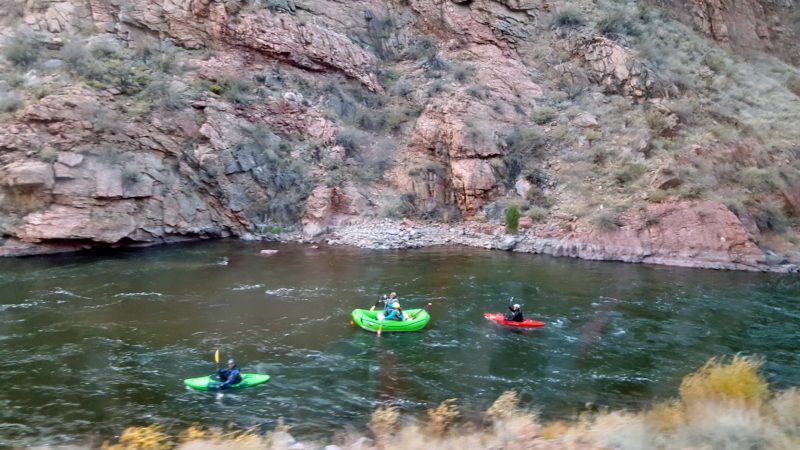
We saw about a dozen whitewater rafters navigating the Arkansas River.

Near the top center, look for the red dot. That is three joined cable cars crossing the Royal Gorge.
We just managed to squeeze this enjoyable two-hour activity into our trip. The train schedule is down from four runs daily in the summer to one run each on Saturday and Sunday, and next weekend is the last trip until spring. For Ted and me, it was another highlight of the wonderful vacation we’re having in the Southwest.
Ted and I started our day with a visit to the Taos Pueblo and ended the day in Pueblo, CO–in other words, we went from pueblo to Pueblo. (Insert groan here.)
The Taos Pueblo is over 1,000 years old. It is a UNESCO World Heritage Site, and is an active, living community, not a reproduction of pueblo life. All of the pueblos belong to the community, but the homes in the pueblos belong to individual families. Living in the pueblo means having no modern amenities–no electricity or running water. Residents usually have a propane stove for cooking and heating.
In 1847, the Taos Pueblo revolted against the U.S. Military and won. The Taos Pueblo people have never been conquered, and have maintained their culture and tradition. Tiwa is the native Taos Pueblo language. It is an oral language and could disappear quickly, so the tribal elementary schools teach Tiwa and English. Tribal high schools require an additional foreign language, so tribal members are fluent in at least three languages. The Spanish brought Catholicism to the tribe, and the church in the pueblo is Catholic, but tribal members also practice their native religion. Yesterday, we were unable to visit the Taos Pueblo because the tribe was celebrating a native religious holiday.

Here is a portion of the wall that surrounds the Taos Pueblo. It was originally 13 feet high for protection.
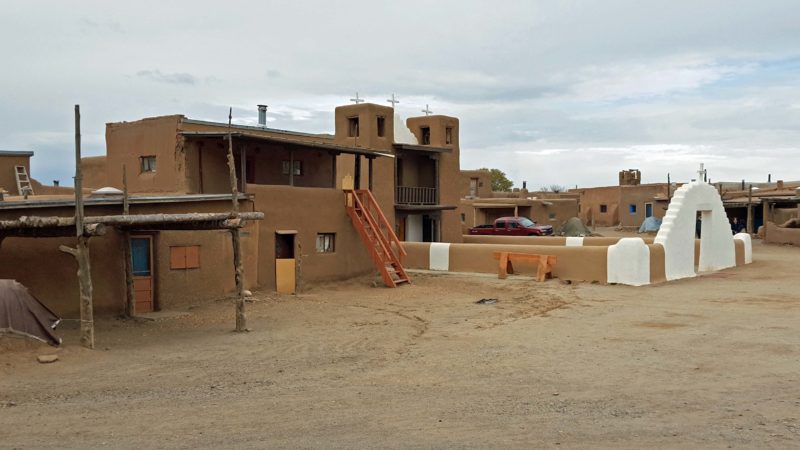
The white arch is the entry to the churchyard. This is a Catholic church. Only the far end of the building (crosses on the roof) is the church; the other part is pueblo homes. More homes are in the right background.
There are currently four resident families in the pueblo, numbering about 25 people, but there are another 1,500 tribal members living on tribal land outside the pueblo. As long as they are living outside the pueblo wall, they may have a modern lifestyle. Tribal members pay federal taxes, but they have their own tribal government. Most people use their pueblo home as a second home: they live outside the pueblo walls, but return to the pueblo for religious holidays and community events. Many of the homes are shops, selling food and handmade items to tourists.
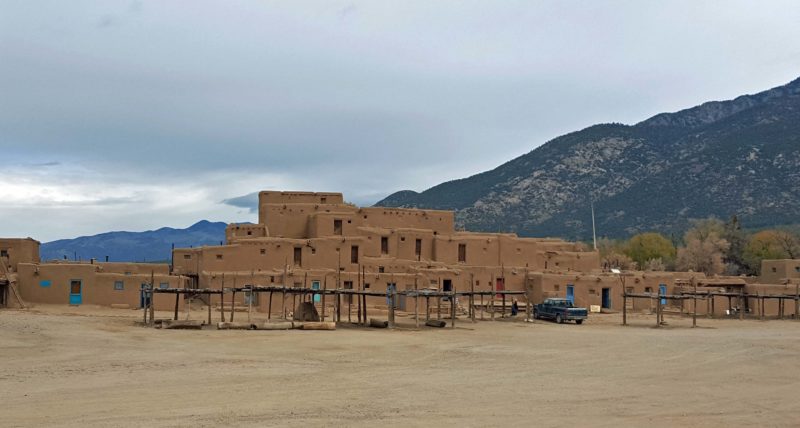
This is the largest building in the Taos Pueblo, and has five levels. Each doorway is a separate home. The homes are small–about 12 feet square with low ceilings. Food is prepared in adobe ovens or on propane stoves. The adobe walls in all the pueblo buildings are 3-5 feet thick to keep the interior cool in the summer and to keep it warm in the winter.
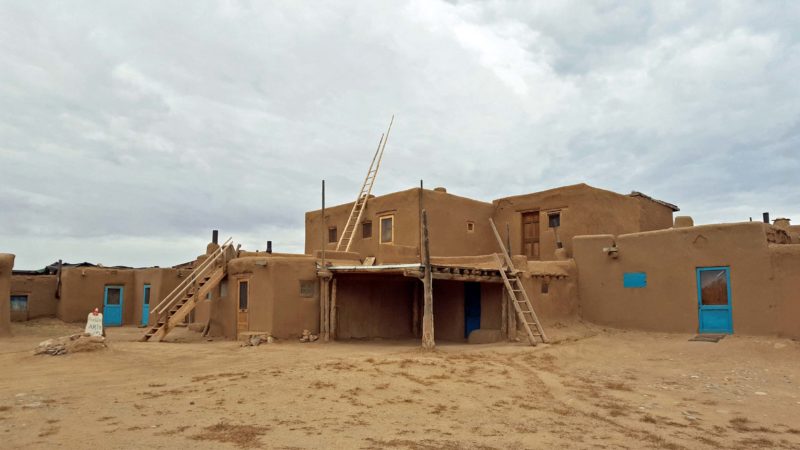
Originally, pueblo homes had no doors. Ladders were used to climb up to the roof and then to climb down into the home through a “skylight.” This provided protection from intruders. Today, the homes have doors cut into them. Many are painted blue to ward off evil spirits.

This is a view through a series of drying racks. Meats and vegetables are hung on the upper crossbars to dry and preserve for future use.
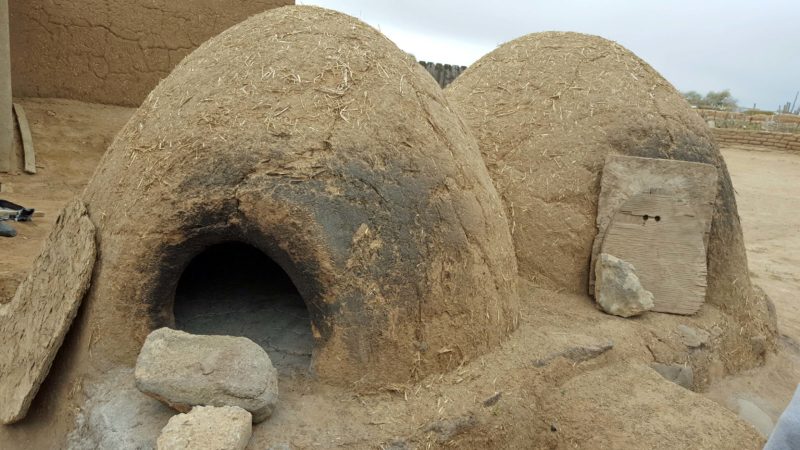
Adobe ovens are used for baking. Cedar wood is burned inside for about an hour to heat the oven. Then the wood and ashes are removed, the to-be-baked goods are put inside, and the door is covered. The inside baking temperature is 300-400 degrees, and each oven can hold 25-30 loaves of bread.
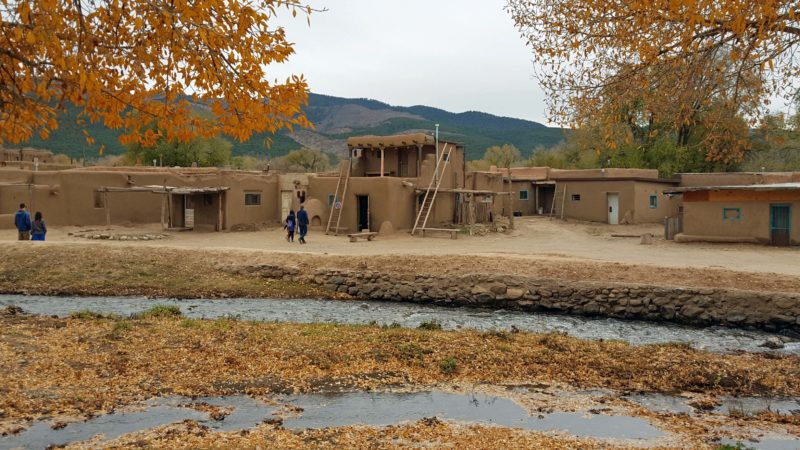
The center structure is another multi-story pueblo. Smaller pueblo homes surround it. To grasp the size of the pueblo homes, subtract 3-5 foot thick walls from the exterior measurement. The stream in the foreground comes directly from the mountain and is untreated, but it is so clean that it can be used for everything–washing, cooking, bathing, etc.
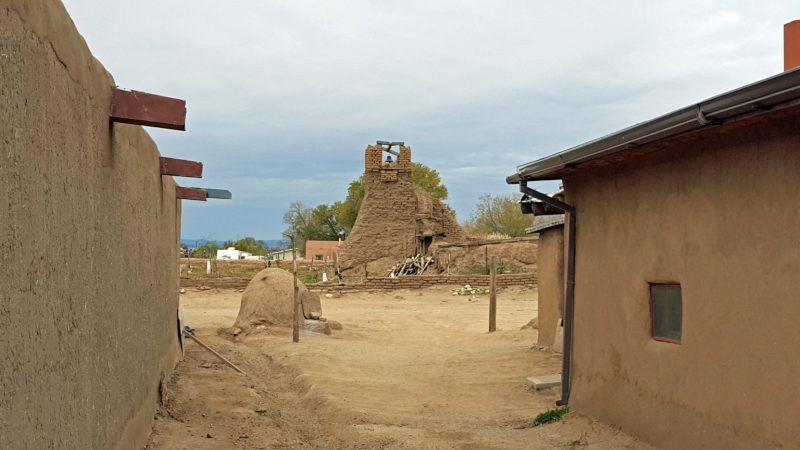
The center building with the bell tower was the original pueblo church. The U.S. Military destroyed it during an attack, believing that the pueblo residents were hiding in it. (They had actually hidden in the mountains.) The original churchyard area is now used as a cemetery. There is an oven in the center of the picture and pueblo homes on the left and right.
After our visit to the Taos Pueblo, Ted and I had lunch at a microbrewery in Taos. Local restaurants are always interesting. This one had a “painting” made of beer bottle caps.
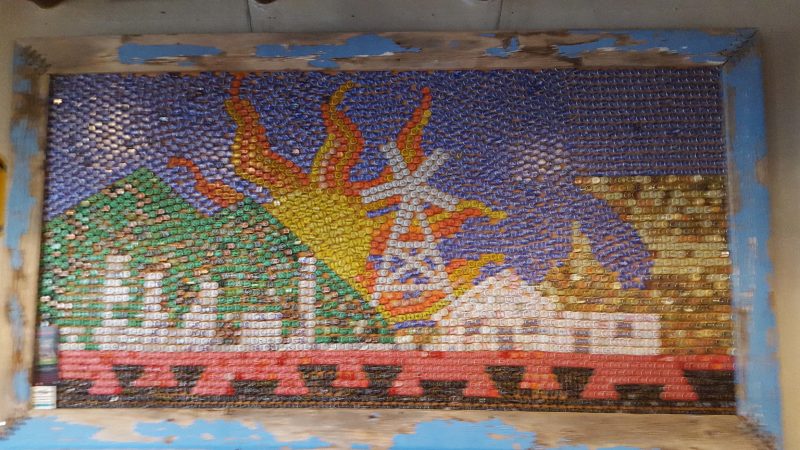
I apologize for the blurring, but you get the idea of how creative a beer-cap artist can be.
Ted and I have been driving scenic roads whenever we can. Today, we followed New Mexico SH64. It was curvy, mountainous, and beautiful. I think our average speed was under 40 mph, but we were in no hurry and the views were worth it. Part of the highway was named the “Enchanted Circle Scenic Byway,” and quite a bit of it was the historic Santa Fe Trail as well.

Winter is getting closer, and it’s becoming a challenge to find fall colors on the trees. Picture yellow-gold leaves on these trees.
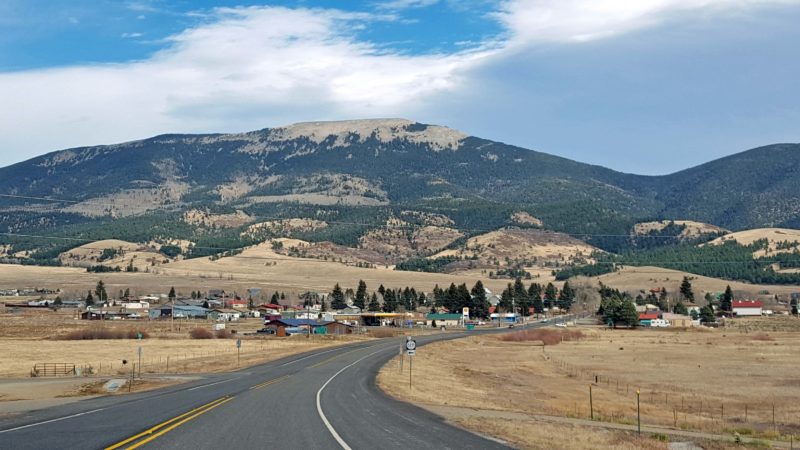
Here’s a village nestled in a valley.
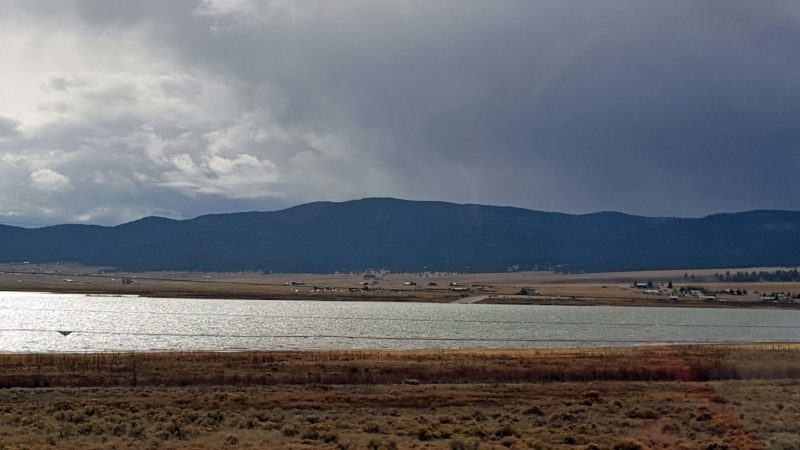
To quote Sting, “Heavy cloud, but no rain” to spoil our views on SR 64.
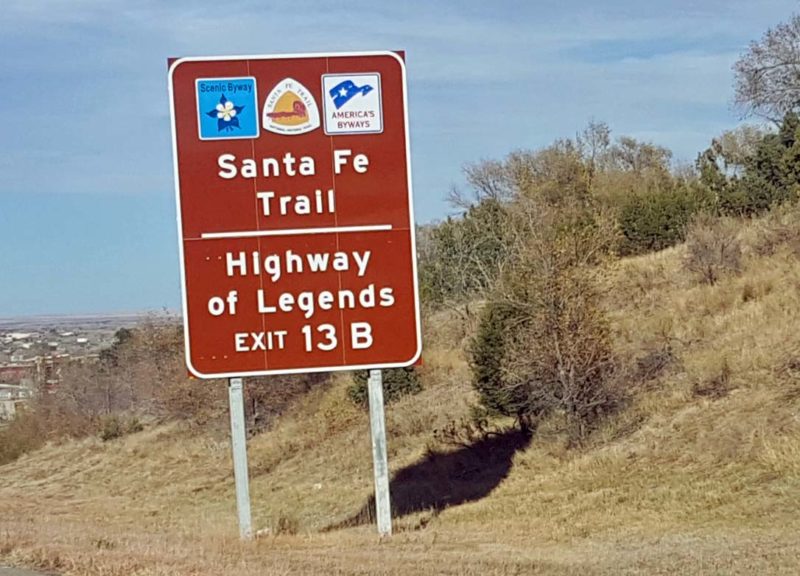
The Santa Fe Trail continued on I-25.
After visiting Roswell, NM and Hooper, CO–two sites where large numbers of people have reported sightings of UFOs, Ted seems to be getting into the mood. He thought he saw a UFO in the sky today.
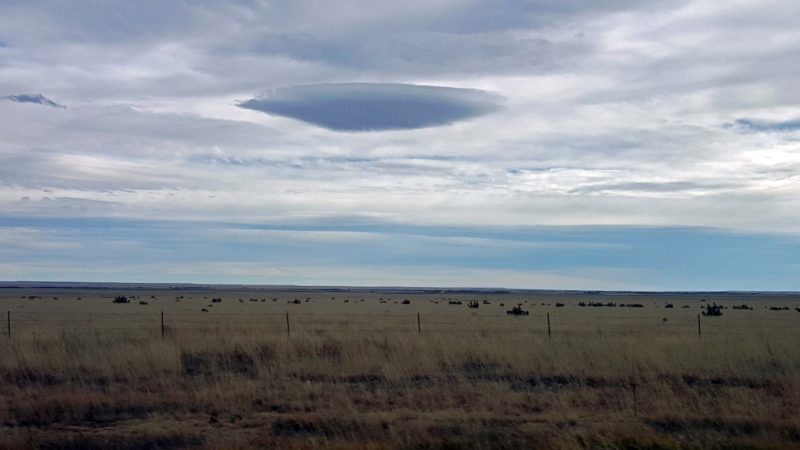
Oh, those funny meteorologists!
Ted and I are back in New Mexico today. Can you believe that, after waiting so many years to check New Mexico off our “states visited” list, we’ve been in the state twice on the same road trip?!
On our drive to Taos, NM today, Ted and I drove over the Rio Grande Gorge Bridge. There’s a parking lot at one end of the bridge, sidewalks along both sides of the highway, and an overview area on each side in the center of the bridge. We parked and headed for the overview areas. Ooops! As soon as the bridge left solid land and went over the gorge, my knees felt weak and I had to focus on looking at the sidewalk and the road–I couldn’t look down, because the gorge is so deep. I stood with my back to the view and checked out the more distant view across the bridge. Ted had to take the pictures again, just like at the Black Canyon of the Gunnison.
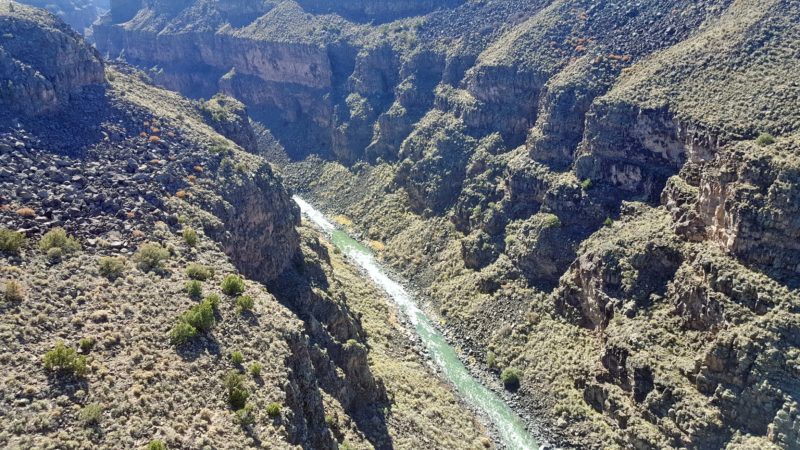
Keep in mind that Ted couldn’t get the top and the bottom of the gorge into the same picture. Also, it’s always a lot farther to the bottom than a photo makes it appear. This gorge was very deep–800 feet.
When we arrived in Taos, the first thing we noticed was the traffic. A two-lane highway runs through the city and it was clogged in both directions. We picked a place to eat based on the large number of cars parked in front, and had a nice lunch. Then we put our car in a public parking lot and set out on foot to explore this colorful and quaint town that seems to epitomize the architecture of the Southwest. Taos is a popular skiing destination and also a cultural center. The streets are lined with art galleries.
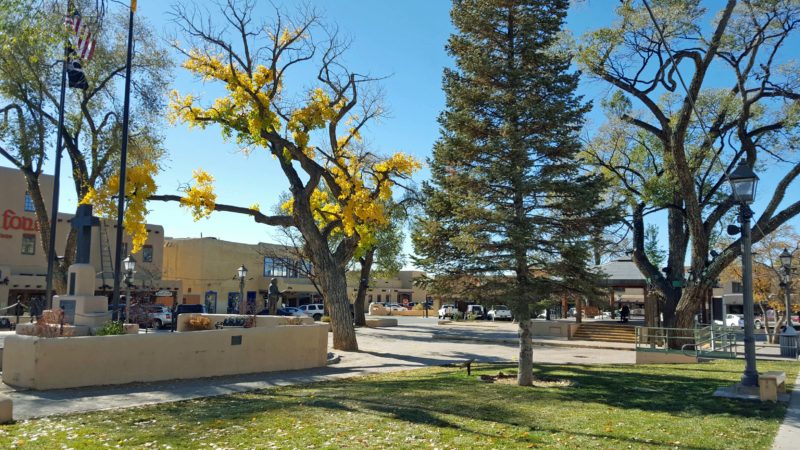
This is the city square. It is surrounded by adobe shops, of course and, like all city squares, traffic goes one way around it.

Here’s a little corner of shops in the historic district of downtown Taos.
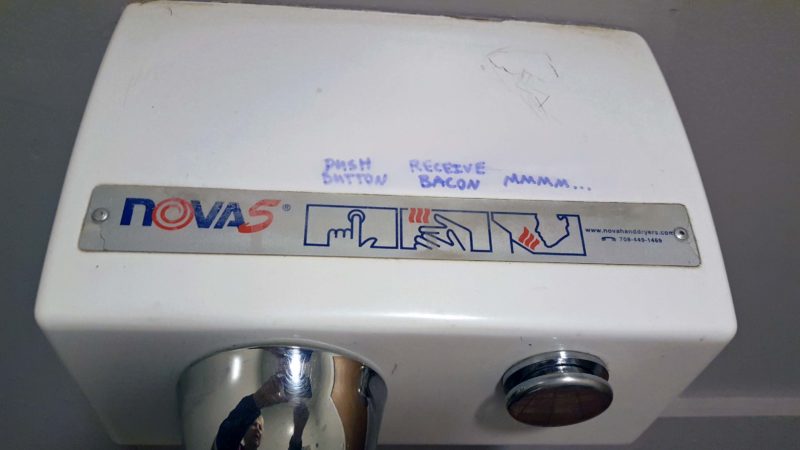
I found an unusual interpretation of the pictographs on the hand dryer in a rest room.
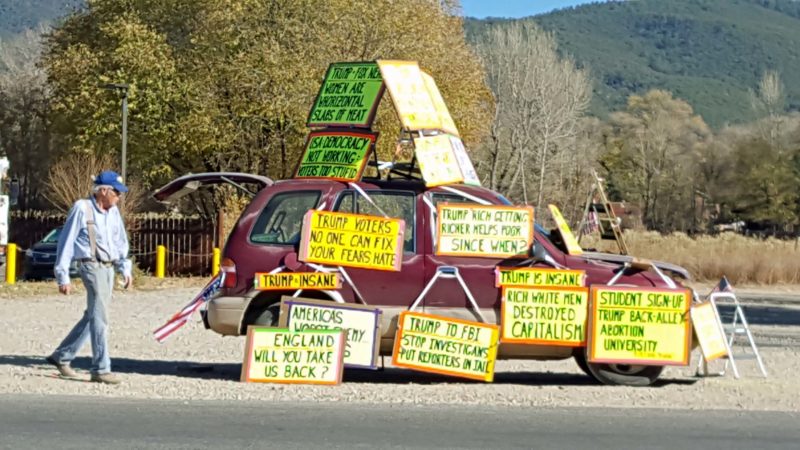
This guy seems to have a permanent parking spot on the main street of Taos. Honk if you agree.

The weather was very nice, so Ted and I stopped at a cafe in the historic district and enjoyed an afternoon snack outdoors.
What a lovely surprise at the end of the afternoon when we checked into our hotel. Ted finds hotels through his AAA travel books and through Google, so we’re never sure exactly what they will be like, except that they’re clean and have basic amenities. Sometimes we find out the hotel is geared toward hunters (signs advising guests not to clean game in the room), and sometimes they’re more luxurious than we expected. Our Taos hotel is 0.4 miles from downtown–walking distance–and encompasses nine acres! It’s very Southwestern in style and has beautiful grounds and luxurious rooms. We have a jet tub and a fireplace in our room, and there’s not a game-cleaning rag in sight.
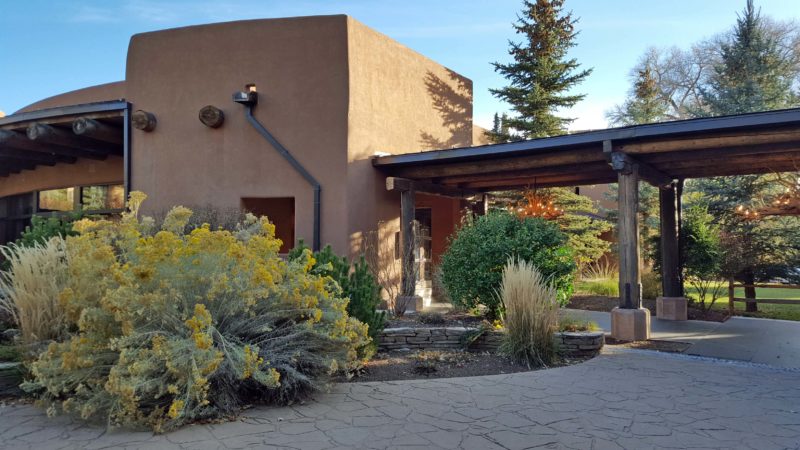
This is the view toward the entrance where the valet met us.
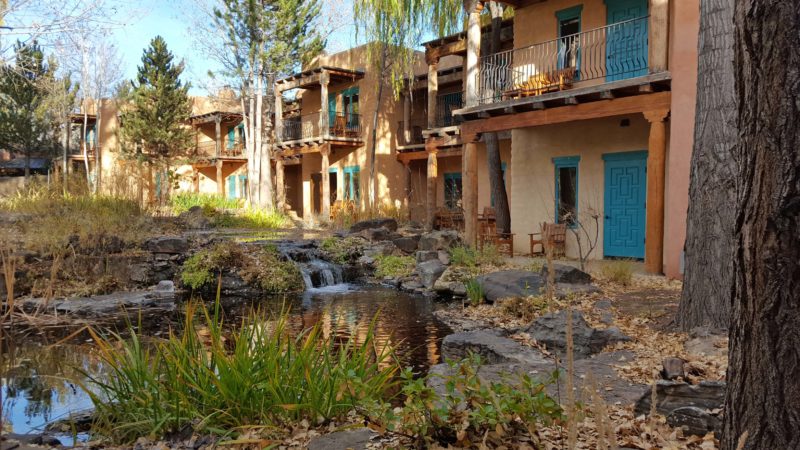
Guest rooms are clustered in small buildings scattered all around the property. Here are some rooms with a view of the Secret Circle of plantings and water features.
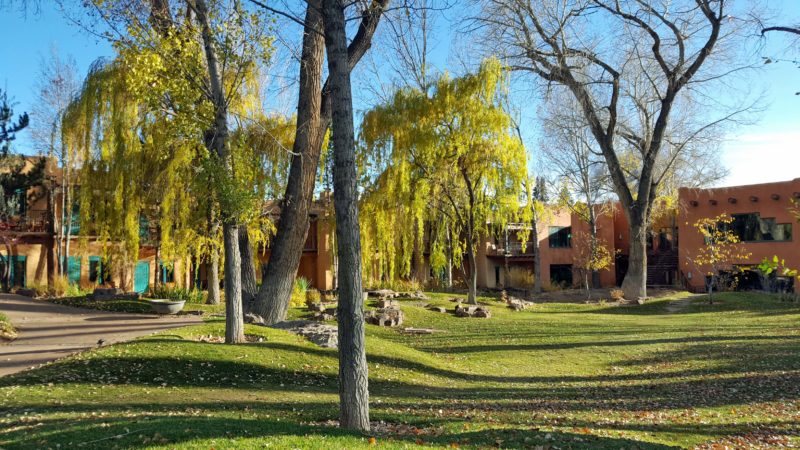
This is a view of the section of the grounds called the Mountain Green.
We had hoped to visit the Taos Pueblo today, but it is closed for a ceremony. The Pueblo is an inhabited, active community, and people in town told us that, yes, every now and then they close for some private event. They are re-opening at 8:00 tomorrow morning, so we’re going to stop on our way to Pueblo, CO.
In mountainous areas, winter weather forecasts regularly mention “snow in the higher elevations.” We saw fresh snow on the ground in many places today, because we’re spending a lot of time at the higher elevations. With the exception of five days below 5,000 feet (Las Cruces, NM; Tucson, AZ; and Las Vegas, NV), Ted and I have been spending our days at elevations of 5,252-11,318 feet since October 13, when we arrived in Albuquerque, NM for the Balloon Fiesta. We can climb several flights of stairs and/or walk vigorously uphill without puffing, so I’d say we’re acclimated to the thinner air.
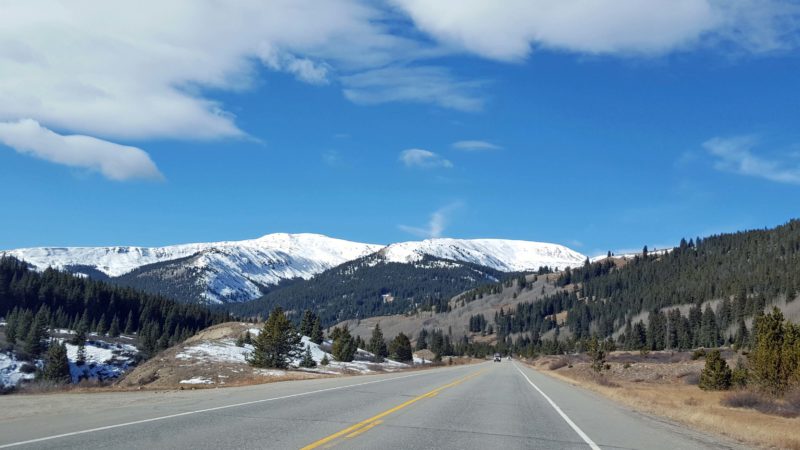
Clean fresh snow on the high mountaintops.

Clean fresh snow at our traveling elevation too. There was ice on the lake surfaces this morning.
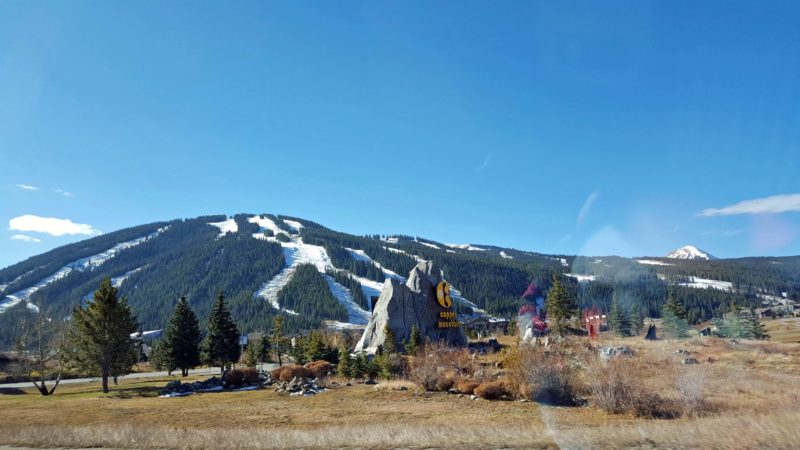
There’s not enough snow at the ski resorts yet, so the snow machines have been busy making the ski runs usable.
We drove through Leadville, CO today and saw some very colorful houses. I remember learning that, in Alaska, people like bright-colored houses to cheer them up during the long, dark winter. Maybe that’s true in Leadville too, because there are a lot of houses painted in cheerful, bright designs.

This house is decorated in shades of blue and green. It’s hard to see, but the second house to the left is done in shades of red and pink.
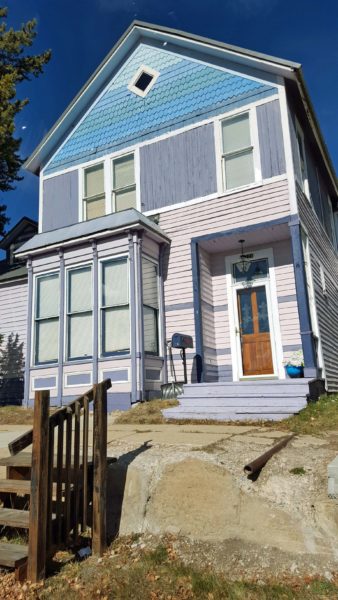
This homeowner chose blue, purple, and pink for his colorful facade.
The UFO Watchtower near Hooper, CO was along our route today, so we stopped for a visit. After all, we’ve already checked out the UFO history in Roswell, NM. The Watchtower was started as a joke by a lady who bought a ranch, then found out she couldn’t successfully raise cattle on it. She knew that UFO watchers would sometimes visit her ranch after dark, so she decided to make money by building a gift shop in a saucer dome with a viewing platform.
The San Luis Valley, where the Watchtower is located, is revered among flying saucer buffs as one of the best places in the world to see UFOs. Twenty psychics have visited the site and have identified two large vortexes and outlined them with rocks. The vortex area is known as the “Healing Garden,” and tourists add items to the clutter in the stone circles.
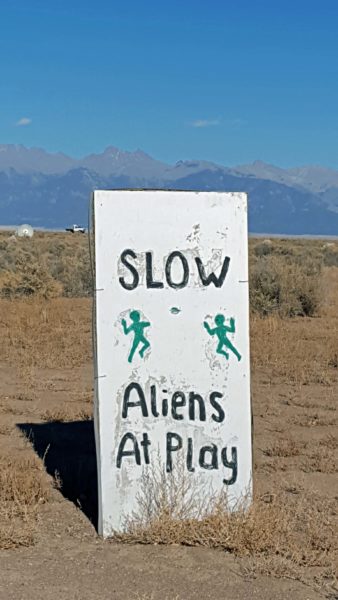
A cautionary sign at the entrance to the Watchtower area.
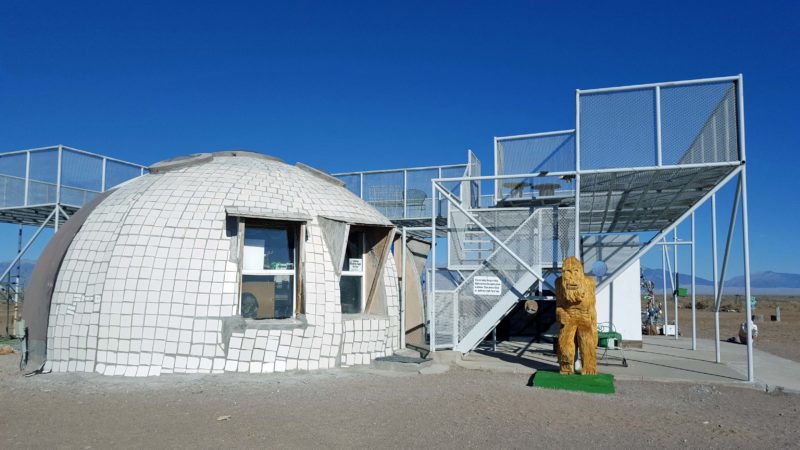
The viewing platform sits beside the gift shop. The gift shop is only open on weekends this time of year, so we couldn’t purchase any alien-type items.

There are two concentric stone circles here. I could only get an (almost) semi-circle in my photo. The stone outlines are a bit hard to see through the clutter.

Here’s the Healing Garden from ground level. Name an object (preferably junky), and there is probably at least one here–ballpoint pens, single socks, a baseball, Mardi Gras beads, etc.
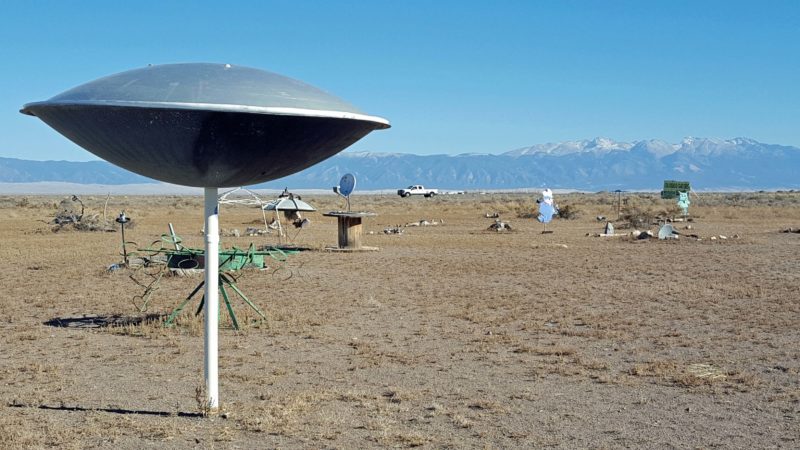
A recovered spaceship?
The highlight of today’s travel was Great Sand Dunes National Park. We visited this park on a trip with our kids in the middle ’80s and had a good time in the sand dunes. (Except Kari, who got an asthma attack–probably from the dust or from the 7,500-foot altitude.) It’s the only national park I can remember visiting that has no “stay on the designated trail” signs. There are no trails in the dunes, and the Park Service has apparently decided that tourists can do no harm to the sand. We didn’t even see a sign telling us not to take any rocks or sand particles out of the park.
These are the tallest sand dunes in North America. The dunefield covers thirty square miles and sits in isolation among the mountains and the desert. It looks a little out of place–like someone put it here and forgot to pick it up and put it where it belongs. Star Dune is the tallest at 750 feet; High Dune is 650 feet. Wouldn’t it be more logical for High Dune to be the tallest? Who named these dunes, the government?
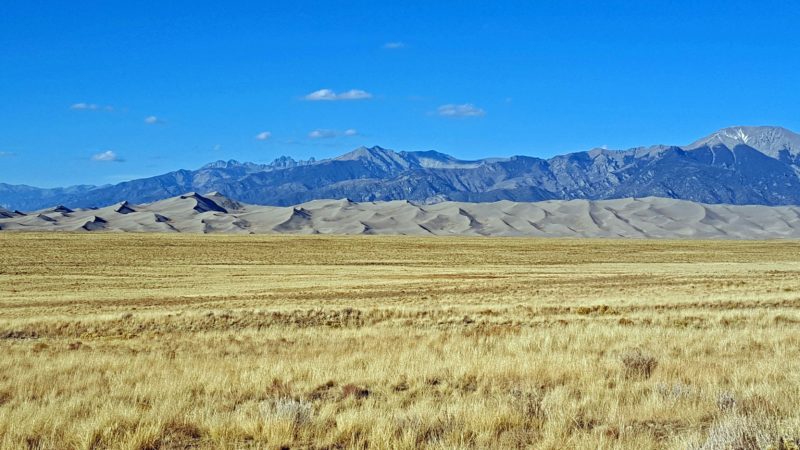
Here’s a long-range shot of the Great Sand Dunes with the Sangre de Cristo Mountains behind them.
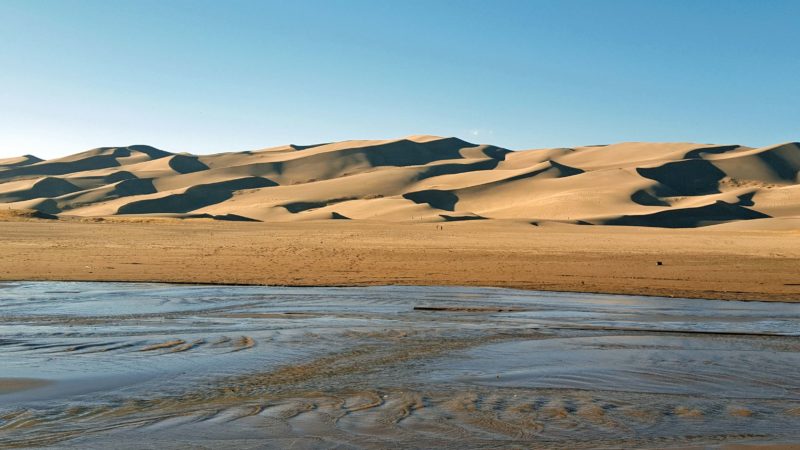
Here’s a picture taken at the base of the dunes.
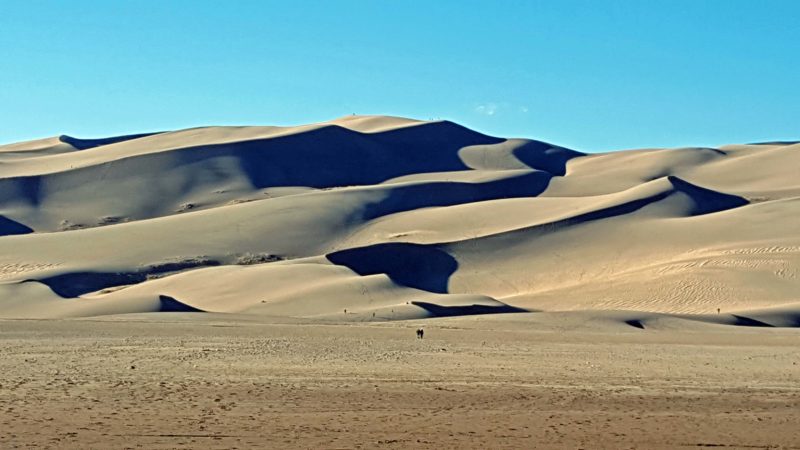
To appreciate the size of the dunes, use the people walking on them and in front of them as a scale. You might have to zoom in on this picture to see the people on top of the tallest dune. There are five people up there. Three people are on the right of the peak, and the figure on the left at the peak is actually two people standing close to each other.
Tonight: Alamosa, CO.
Tomorrow: Taos, NM, a UNESCO World Heritage Site.
Ted and I started our day by taking the pedestrian bridge from our hotel to downtown Glenwood Springs, CO. It was a 5-minute walk vs. a 30-minute drive through the construction zones. We still had to face some of the dreaded orange cones, because they indicated the crosswalk for us to get to and from the bridge.

Does this look like a crosswalk or a barrier? There are two lines of yellow tape strung along the cones; therefore, it’s a crosswalk for pedestrians, but a barrier for vehicles. This is nothing compared to the number of traffic cones at two of the corners we had to drive around yesterday.
Glenwood Springs is an old town and looks very historic–except for the modern-day traffic that is backed up waiting to turn at the corner in the picture above. Traffic was lighter today and there were no traffic cops. I have no idea what made yesterday so special that everyone wanted to clog up the streets.

The back-up continues to the right of the photo. Somewhere around the distant rise in the road in the left center of the picture is the corner where these cars can turn left. If we could have gone straight here yesterday, we’d have been at our hotel just across the bridge.
Our goal today was to visit the Railroad Museum. Admission is $2.00 and the docent will start the two model trains whenever visitors ask to see them run. It’s obviously not a world-class museum, but the depot is an interesting building and the museum is housed in what used to be the Ladies’ Waiting Room, so it sounded like an interesting way to spend a little time.
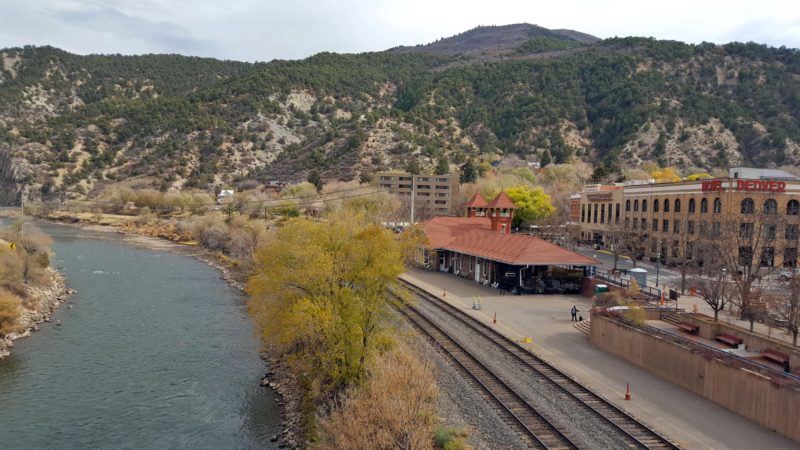
The red-roofed building is the still-active train depot as seen from the pedestrian bridge. The Colorado River is flowing on the left, and the historic Hotel Denver is on the right.
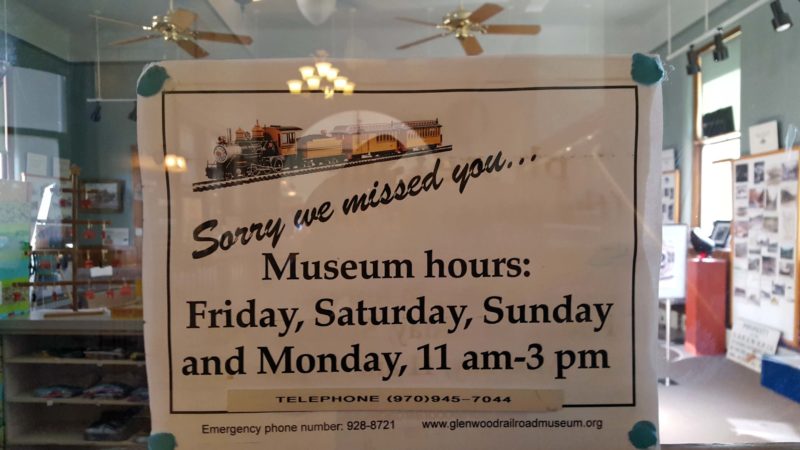
This is what greeted us at the museum door. Today is Wednesday. The “season” seems to end in this area the last weekend in October, so a lot of businesses have reduced hours. On the bright side, hotels are cheaper.

We could see through the windows. This is the entire museum. The tracks for the two model trains are visible on the table in the right center of the photo.
Moving on, we had a delicious lunch at a restaurant in the Hotel Denver and then walked around and admired the beautiful historic 4½-star hotel.
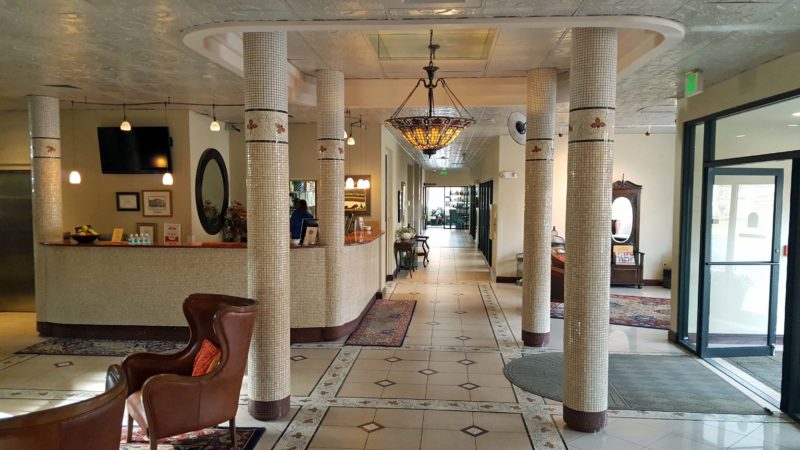
Here’s a view down the hallway from the lobby.
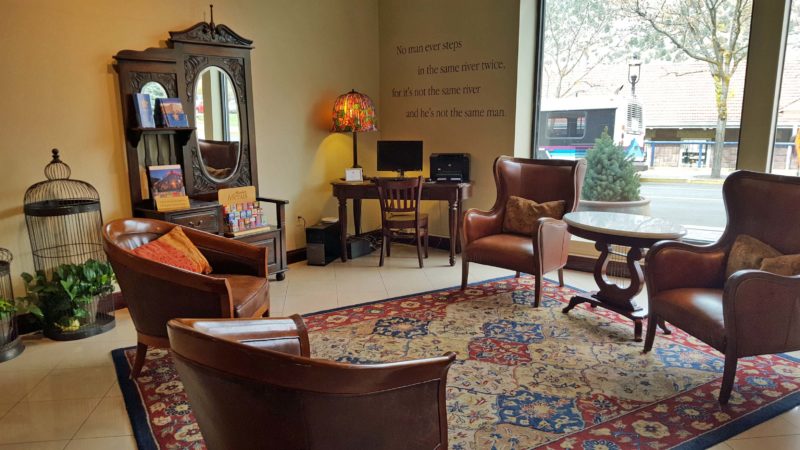
This is the seating area across from the check-in desk in the above picture. On the other side of the front door is a similar room with a grand piano.
We drove I-70 through the Glenwood Canyon and had more scenic mountain views most of the way to Vail. Here are some that were a little different than what we’ve been seeing every day. The snow on the mountaintops is fresh.
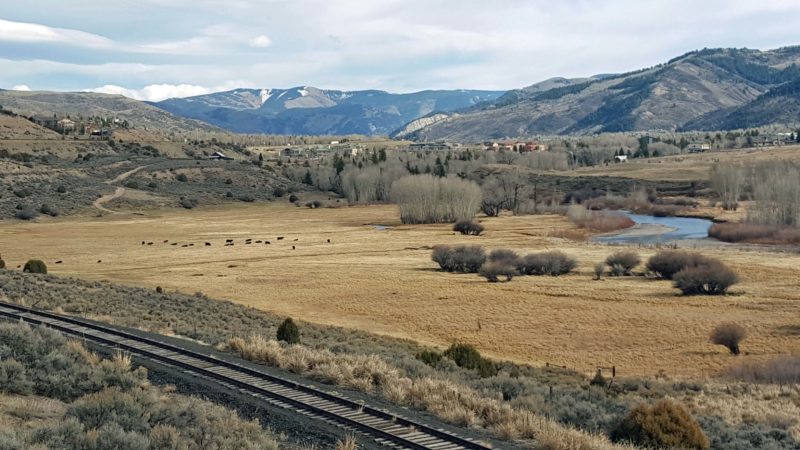

We had a very enjoyable afternoon in Vail, despite temperatures in the mid-40s and a wind advisory. Vail’s bus system is free and has a bus stop at our hotel door, so we took the bus to the town of Vail and then to Lionshead Village. After returning to the hotel to freshen up, we took the bus back to Vail for dinner.
The town of Vail was built as the base village for the massive Vail Ski Resort–the largest ski mountain in Colorado. The town has Bavarian-style architecture and is pretty and charming, but pure tourist-y.

Some of the Bavarian-styled shops in Vail.
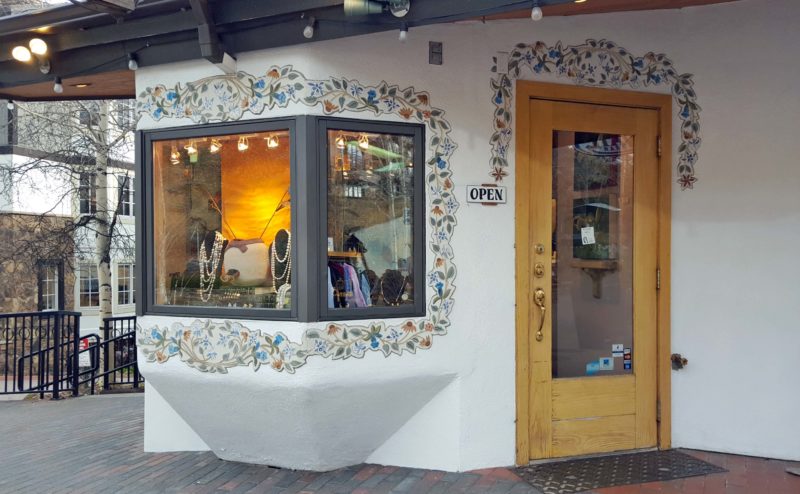
I thought this was the prettiest shop.

This is my picture postcard view of Vail from the covered bridge in the town.

Notice the snow fences on the roofs of the buildings. Some buildings had signs warning passers-by to watch out for snow falling from the roofs. No danger of that today.
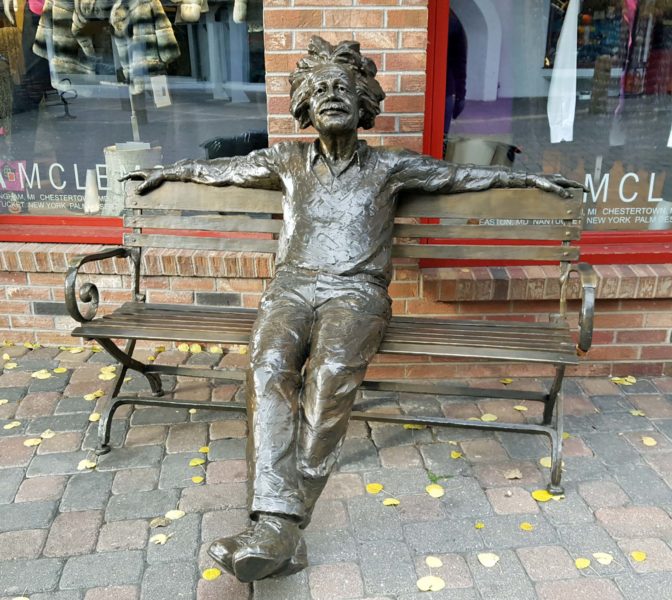
There are sculptures everywhere in Vail. Most are very art-y, but this one of Uncle Albert was more playful.
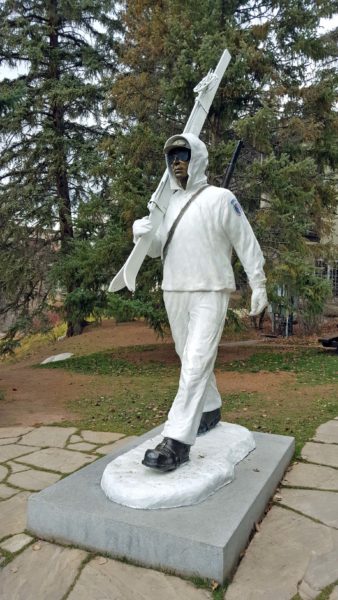
This sculpture is a memorial to the ski troopers. The ski troopers fought in Kiska, the Aleutian Islands, and Italy in WW2.
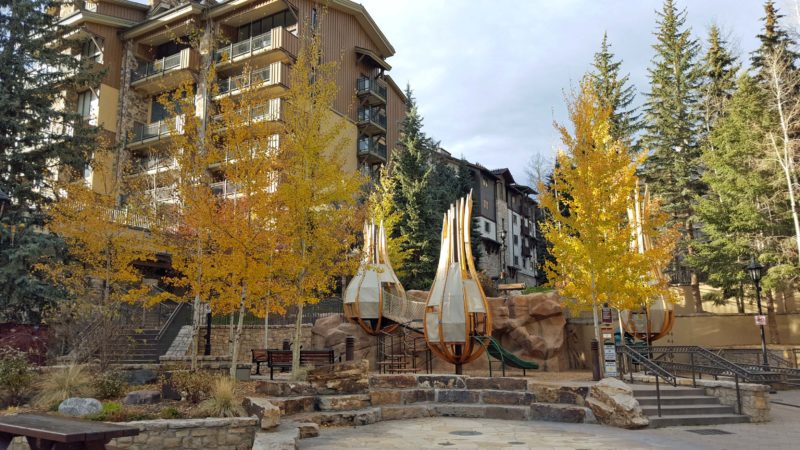
A few trees still have leaves, making this a pretty little park.

At night, the twinkle lights come on. I assume there will be many more twinkling in the next few weeks.
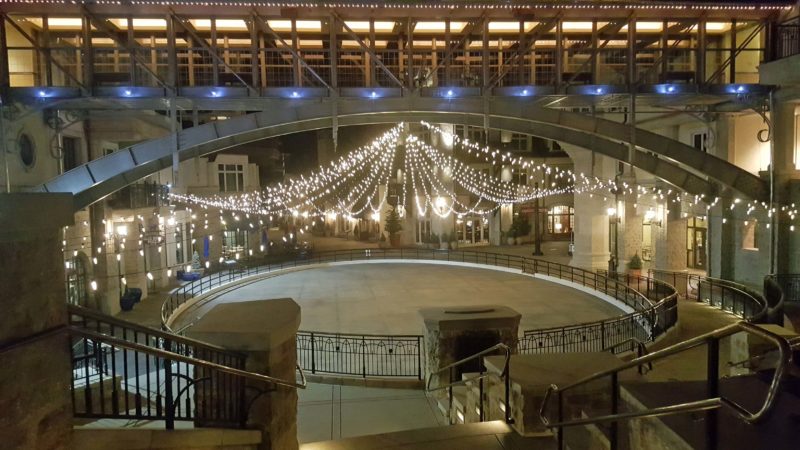
This is a skating rink. No ice on it yet, but man-made snow already marks the ski trails on the mountains.
One of the sidewalks in Vail had a puzzle stamped into the blocks. Any readers who like to work puzzles have probably seen the type that instructs you to change one word to another in x-number of moves, changing one letter at a time. The sidewalk changed bird to hare in eleven moves. If you’re challenged, try it. The solution is at the bottom of this post.
And then there was pie. As Ted and I were selecting a restaurant for our dinner and reading the reviews, we saw this one.


Guess what we had for dessert tonight. Warm fried blackberry pie with fresh blackberries, covered with cinnamon sugar, and topped with vanilla gelato and shaved white chocolate curls.
I asked the waiter how they make this pie. Partially bake a pie crust circle so it will hold together. Add mashed blackberries and fold the crust over to make a semi-circle, then crimp the edge. Bake it a few minutes to set the crust, then deep-fry it until done. Cover with cinnamon and sugar, and add the trimmings. It was a delicious dessert choice and unlike any pie we’ve ever had before.
During the afternoon, we saw a store with a green cross on it and remarked that, in Europe, a green cross indicates a pharmacy. Sure enough, a sign indicated that this store sells “natural medicinals” and provides “recreational sales.” Oh, that’s right–we’re in Colorado and it’s legal here. Then, this evening, we saw this in a different store window.

Define “high”–8,150 feet or natural medicinals?
Glenwood Springs and Vail were fun. Here’s the puzzle solution:
Bird-bard-lard-lord-load-toad-road-read-head-herd-hard-hare. Each word was stamped in sequence in a trail of sidewalk blocks. Clever!